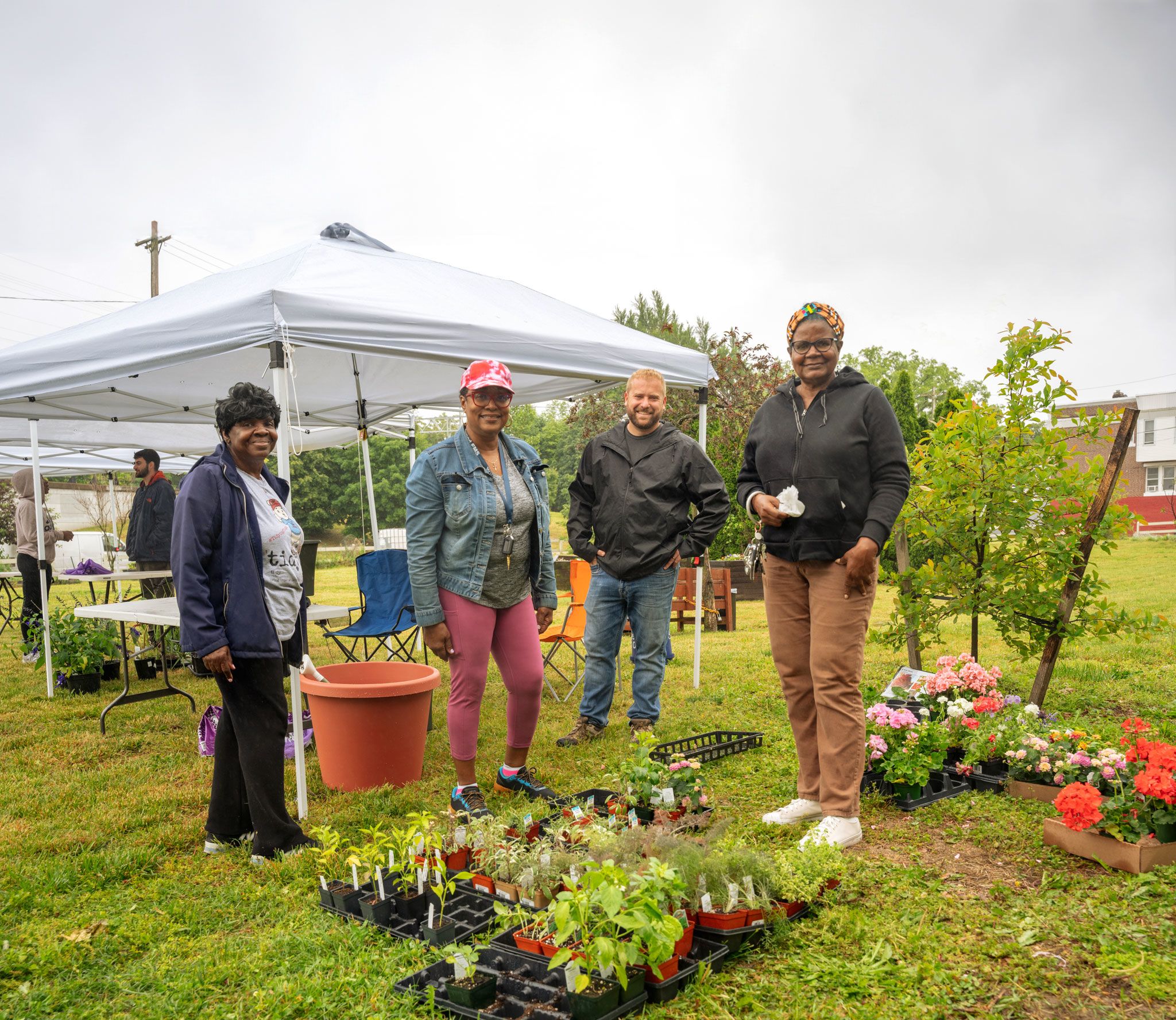
LIVING COLOR
Plants brighten your world inside and out
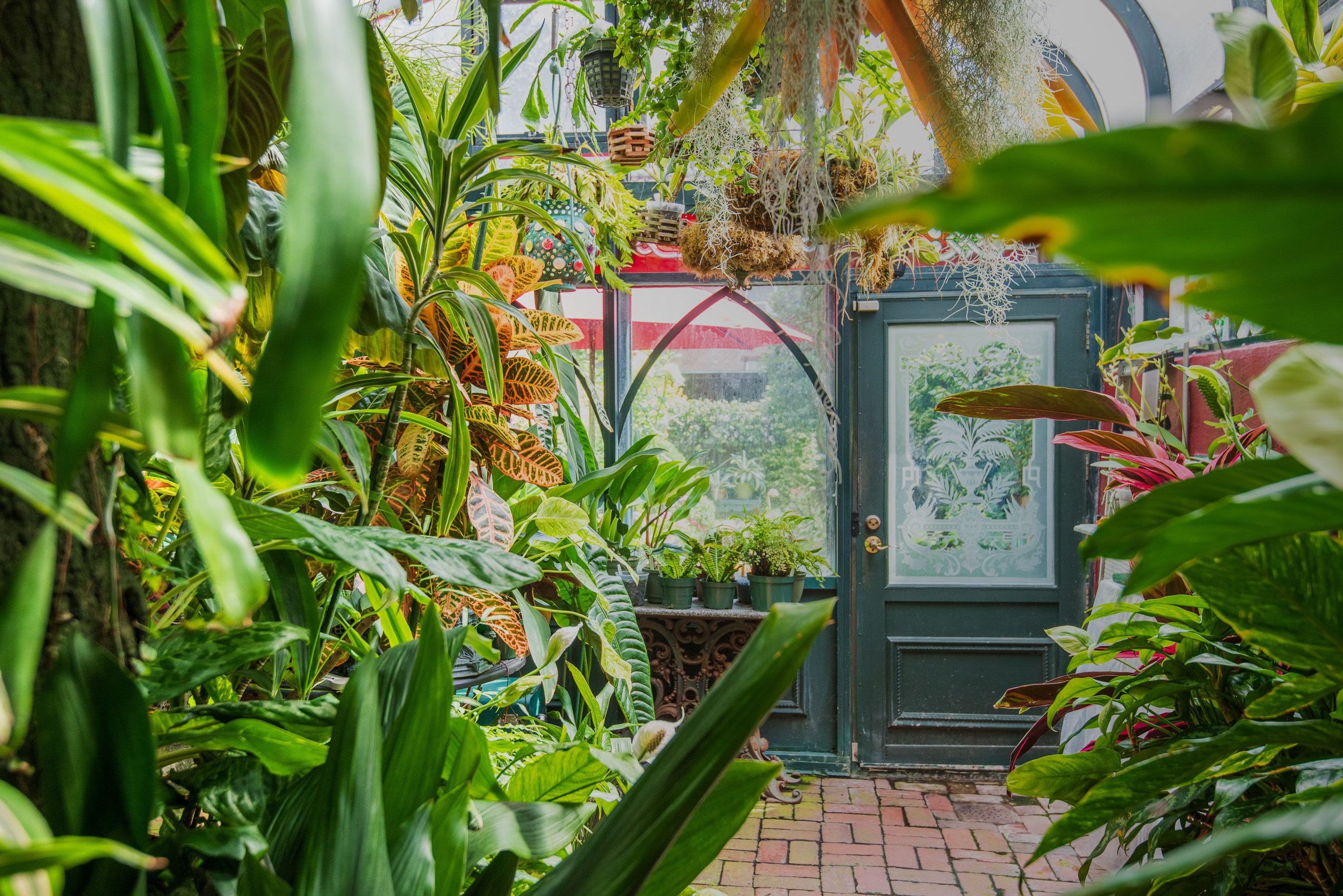
Cover Photo: John Whitenight's stylish conservatory in Philadelphia is a haven for his collection of exotic philodendrons, anthuriums, and orchids.
photograph by ROB CARDILLO
IN THIS ISSUE
Feature Story
Two of Spades
A pair of horticulture pros create a garden that reflects their love of plants and each other.
Go to PHSonline.org
All photos (except where noted) and text by Blue Root Media. Design by Iris Creative.

A pair of horticulture pros create a garden that reflects their love of plants and each other.
by SCOTT MEYER
photographs by ROB CARDILLO
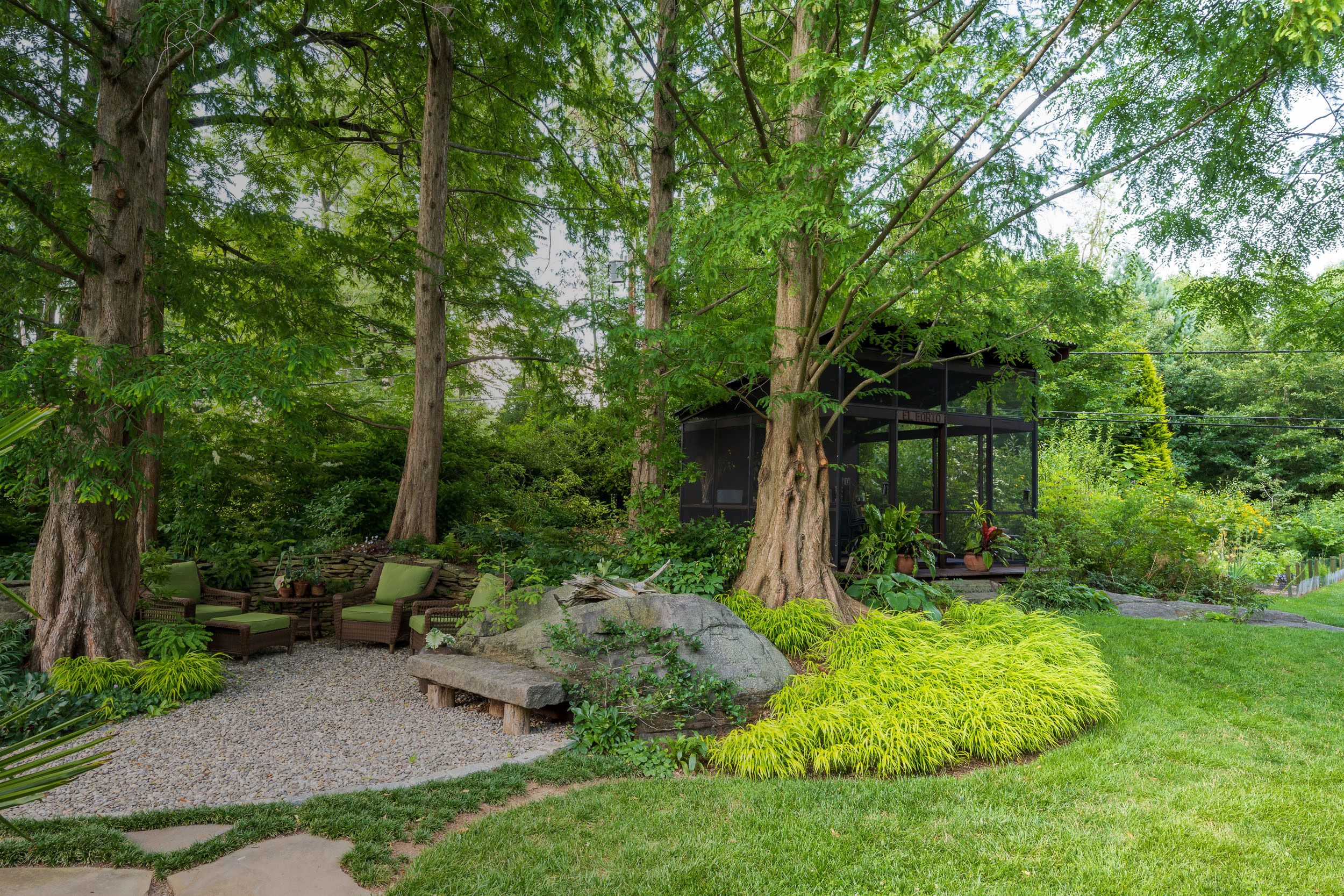
Above: A group of towering dawn redwoods provides shade to the landscape and keeps the comfortable seating area beneath them cool.
Step through the front door of the cozy home of Peggy Anne Montgomery and Dan Benarcik and you get a clear view through their house and straight into their backyard landscape. That view is the central feature of their house. For the couple, gardening is more than a hobby or a profession. It’s their way of life. They both have made their careers in horticulture, and they found each other through their work. And on their 1-acre plot in northern Delaware, they’re collaborating on a garden that’s an ever-evolving expression of their passions, knowledge, creativity, and relationships.
“We like to make people smile when they see our garden,” Montgomery says, “though we don’t do this garden for anyone but us. We do it to delight each other.”
MEETING OF MINDS
Their love of plants and horticulture is what brought them together in the first place. Montgomery grew up in Minnesota and enjoyed spending time in the gardens tended by her mother and her grandfather. She later studied early childhood development at the University of Minnesota, and after a few years of working at a local nursery, she moved to the Netherlands. “It was a great experience because I was paid a stipend as I learned about all aspects of horticulture,” she says. She later operated her own landscape design business there.
Montgomery returned to Minnesota 15 years later and began a job at Bailey Nurseries, a breeder and wholesale vendor. “I started on the planting line, then quickly moved into sales,” she says. She joined the Garden Writers Association (now known as Garden Communicators International) and became friendly with another member, Benarcik, a senior gardener at Chanticleer in Wayne, Pennsylvania.
“After I had known him for years and had donated Bailey varieties to the Delaware Center for Horticulture’s annual rare plant auction [where he was on the plant selection committee], we went on a date at a conference in Portland, Oregon,” she recalls, and they hit it off. “He later gave me this great book about all the public gardens in the Brandywine Valley, and in 2000 when a job became available at Mt. Cuba Center, I jumped at the opportunity. I was interested in native plants [the focus of the center’s work] and I wanted to see about dating this Benarcik guy,” she says with a playful smile.
The Brandywine Valley has always been home to Benarcik, who grew up a few miles from their current house. His mother was a third-generation retail florist, and his father operated one of the region’s first DIY home centers. “I had one foot in the flower shop and the other in the woodshop,” Benarcik notes.
As a child, he didn’t love working as a florist but reveled in getting lost in the woods for hours. “I always felt a sense of wonder at nature,” he says. He was interested in civil engineering but he chose to study plant science at the University of Delaware and later landed a summer job at Mt. Cuba Center. “I answered an ad for a lawn-cutting position, and I left five years later as a ‘woods path gardener.’” After working at a nursery, Benarcik was hired at Chanticleer, where he now is one of six primary horticulturists and manages the in-house woodshop. “I sort of reverse engineered my career,” he says. “Through a series of steps, I found my way to where I am now.”
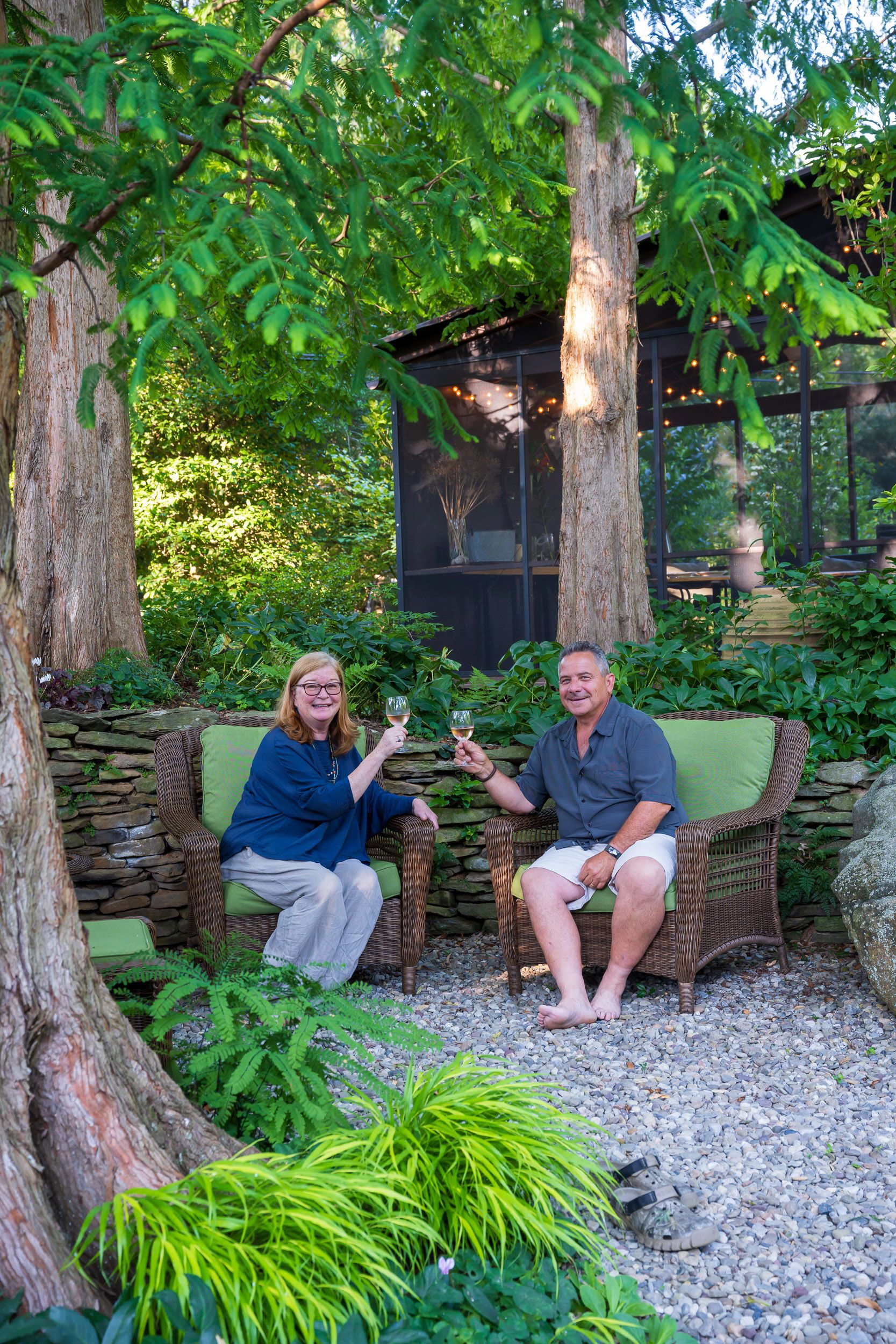
Montgomery and Benarcik spend most of their free time tending the garden, but they also love entertaining family and friends in their backyard.
Montgomery and Benarcik spend most of their free time tending the garden, but they also love entertaining family and friends in their backyard.
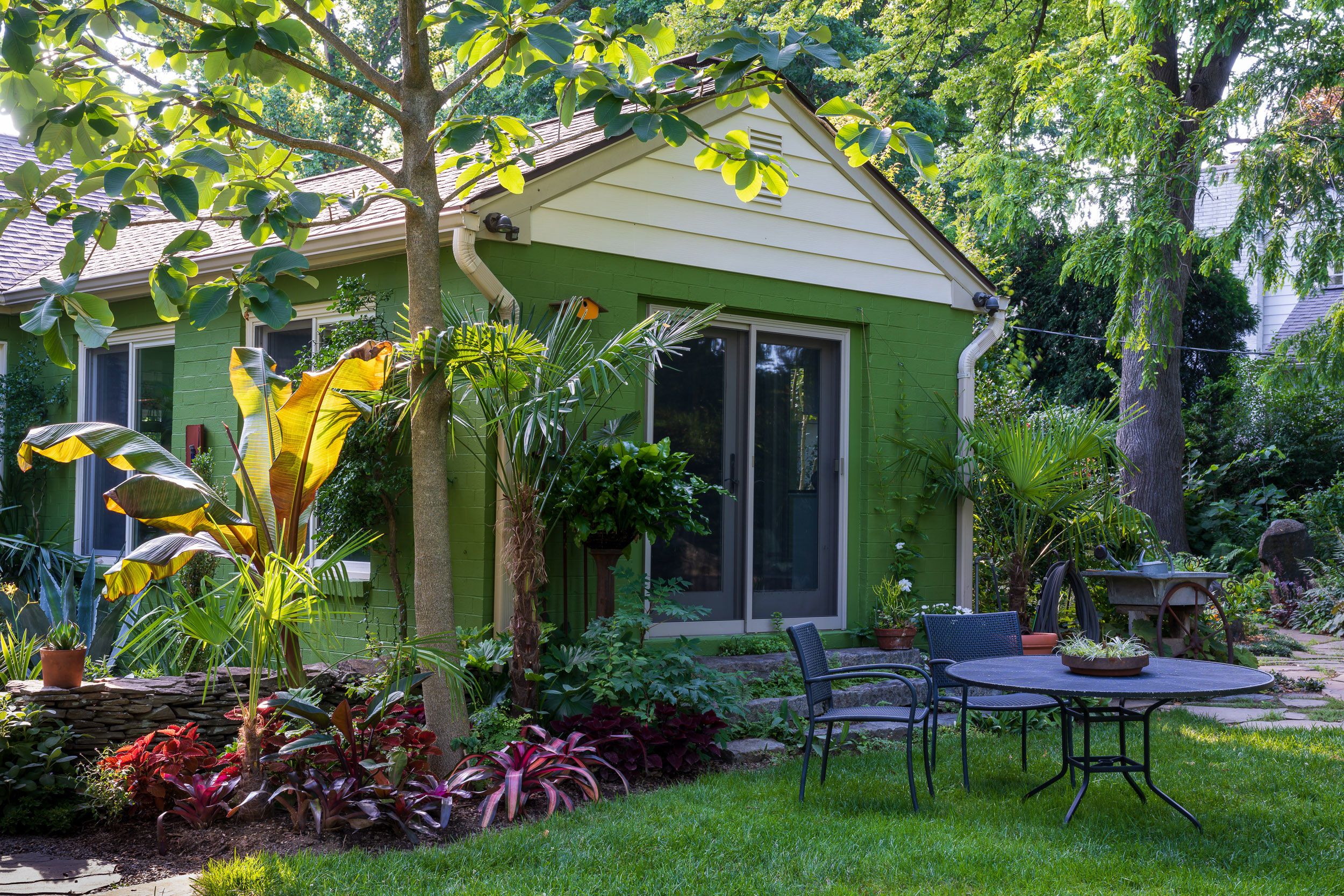
The sliding glass back door offers a clear view from the house's front door straight through to the garden.
The sliding glass back door offers a clear view from the house's front door straight through to the garden.
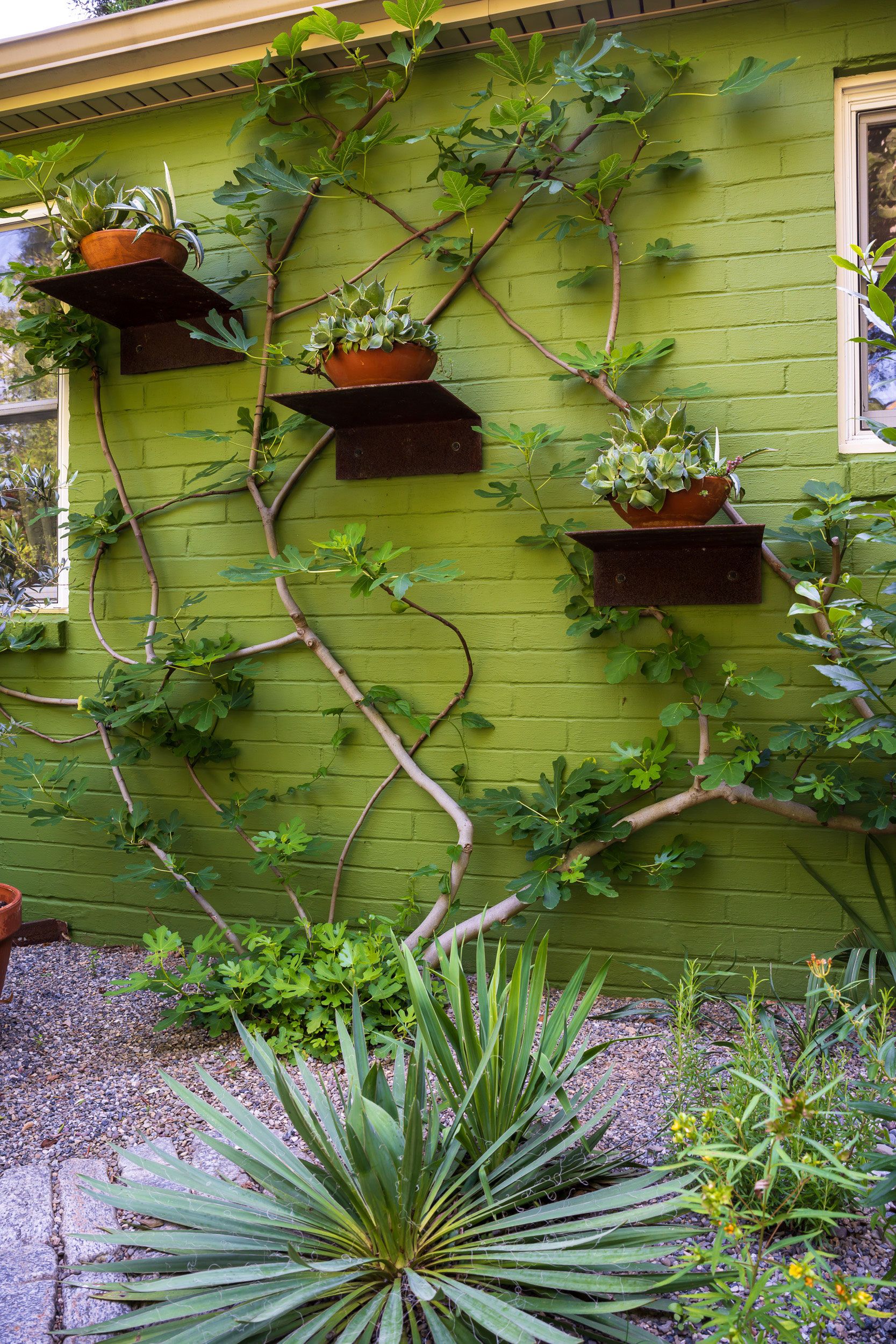
An espaliered fig and pots of succulents sitting on custom-designed steel brackets decorate the wall by the sunny patio.
An espaliered fig and pots of succulents sitting on custom-designed steel brackets decorate the wall by the sunny patio.
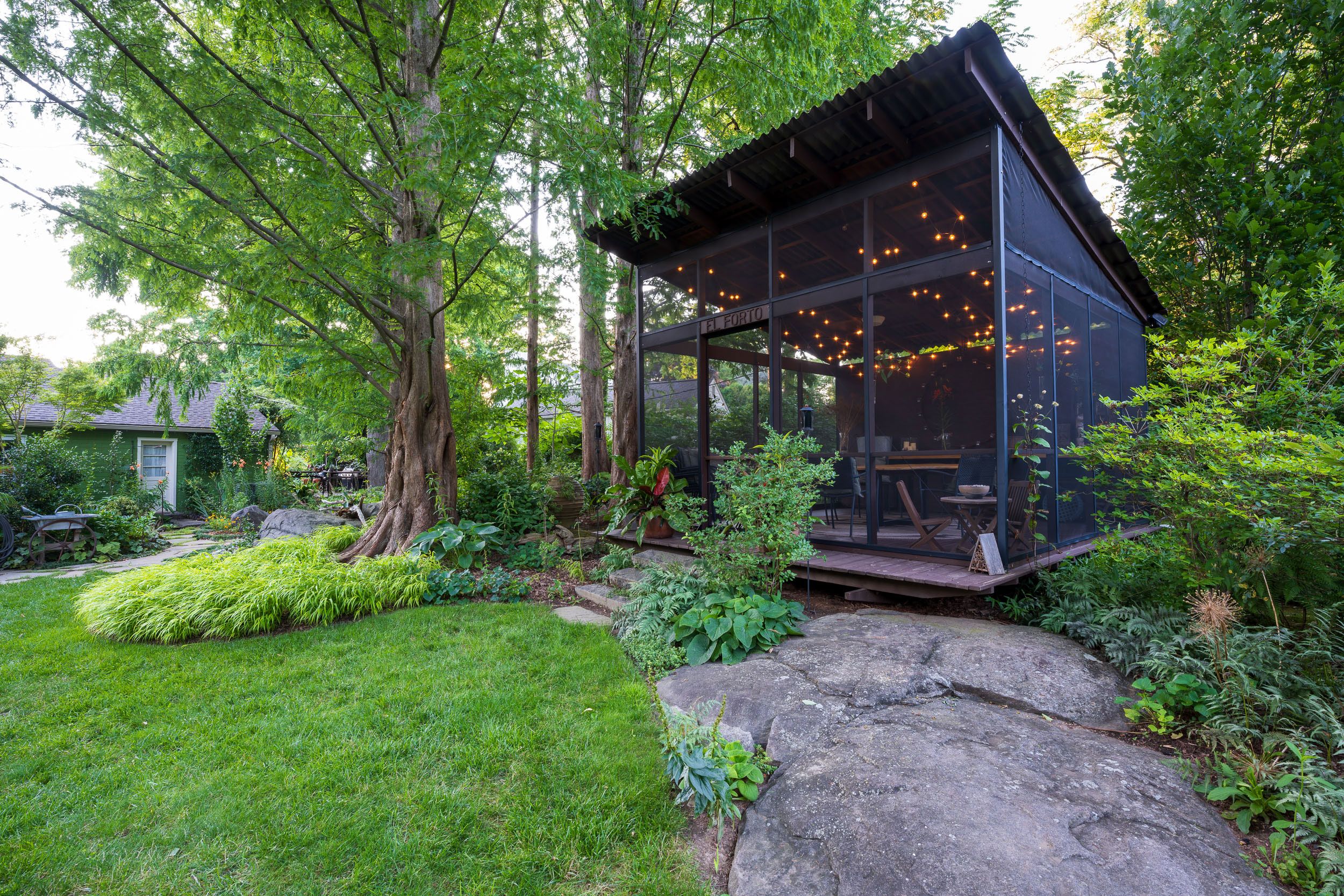
The site for El Forto was carefully chosen so that people inside could see the garden in all directions.
The site for El Forto was carefully chosen so that people inside could see the garden in all directions.
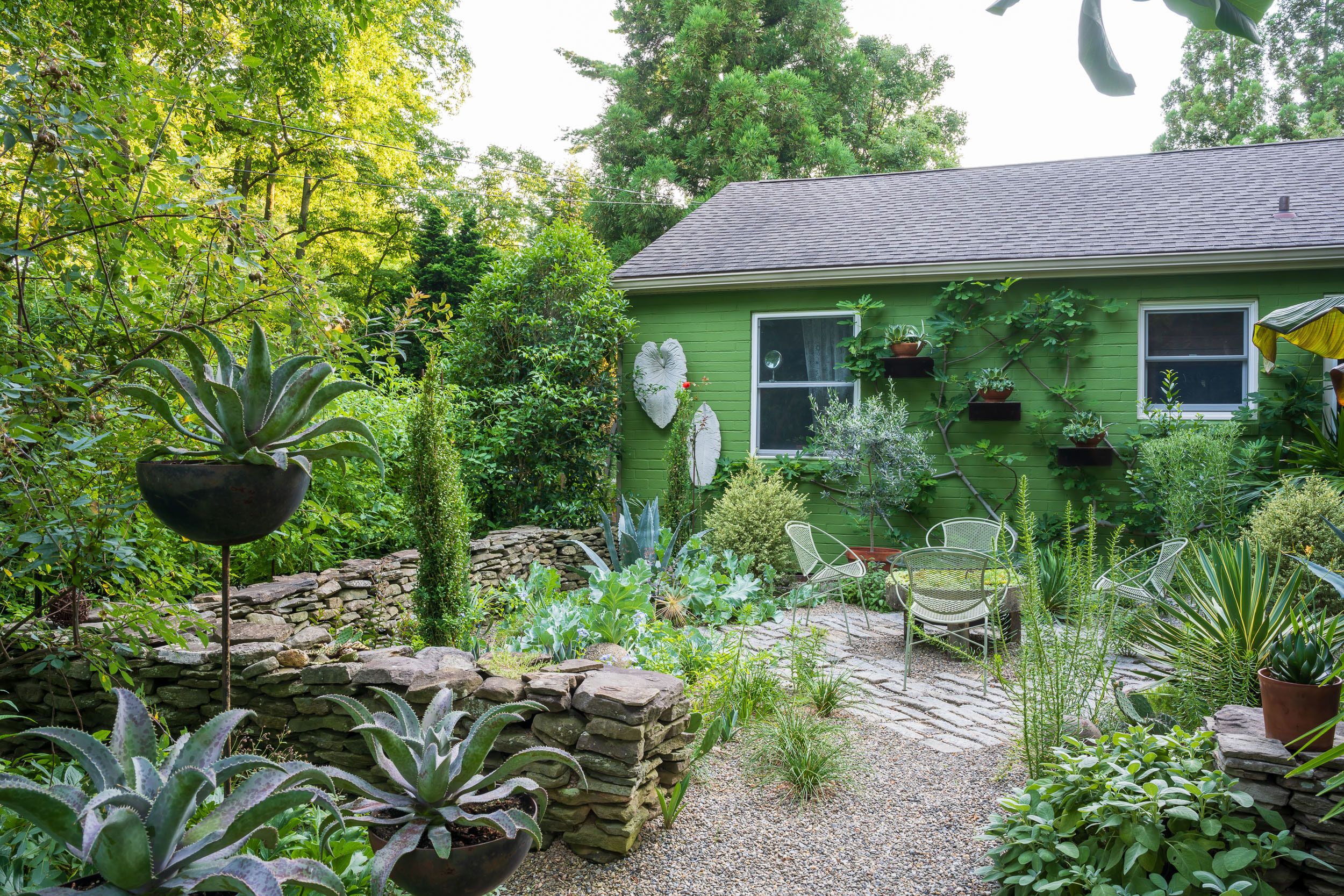
The sunny, Mediterranean-inspired patio features dramatic silver, gray, and green foliage plants.
The sunny, Mediterranean-inspired patio features dramatic silver, gray, and green foliage plants.
HOME TOGETHER
The house the pair live in had belonged to Benarcik’s grandparents late in their lives, and the lot had just the standard suburban lawn with a few trees and shrubs when he moved in more than 20 years ago. “There was a Kentucky coffee tree (Gymnocladus dioicus), and I've always admired those,” Benarcik says.
The house sits forward on the lot, making for a short front yard and a deep rectangle in the back. Benarcik began to populate the landscape behind the house with trees and shrubs, most prominently a group of dawn redwoods (Metasequoia glyptostroboides). When he invited Montgomery to move in, he told her, “I don’t have a fortune to tempt you with or a house at the sea or mountains, but I can offer you my garden.” She accepted the invitation but wasn’t sure if he truly meant it. “I don’t know many people who would be generous enough to invite someone into their garden and let them go,” she says, “but he has been true to his word.” They’ve now been married for 10 years and their shared vision is shaping the space.
A tour starts on a path that wanders amid shrubs such as native American beautyberry (Callicarpa americana) and Hydrangea petiolaris ‘Firefly’. In spring, native ephemerals come up before the shade creates conditions for a mix of foliage plants to fill in.
The winding path leads to a stand of bamboo (Phyllosthachys aureosulcata) that screens the back end of the property from a public walkway. As the path turns toward the house again, it passes through large and expanding patch of moss that has become a new project for Benarcik. (See “Coming Attractions” for more details.) A small patch of remaining lawn borders a long bed of edibles that yields fresh herbs, garlic, and seasonal vegetables the couple use in their meals.
The garden is full of uncommon plants, thanks to their many relationships in the horticulture industry. “We have a lot of friends who are plant hunters and plant breeders, so there are always interesting things coming in,” says Montgomery, who now works as an account executive for Garden Media Group, a marketing firm based in Kennett Square, Pennsylvania. “Like a lot of gardeners, we try to grow plants that aren’t suited to our conditions, and they often die. But we aren’t sentimental about that.”
What is important to the couple are the people and circumstances behind those plants. “This is a garden of stories,” Benarcik says. “So many funny little stories come with the plants,” Montgomery adds. “Those plants and stories are precious to us.”
“So many funny little stories come with the plants. Those plants and stories are precious to us.”
—Peggy Anne Montgomery
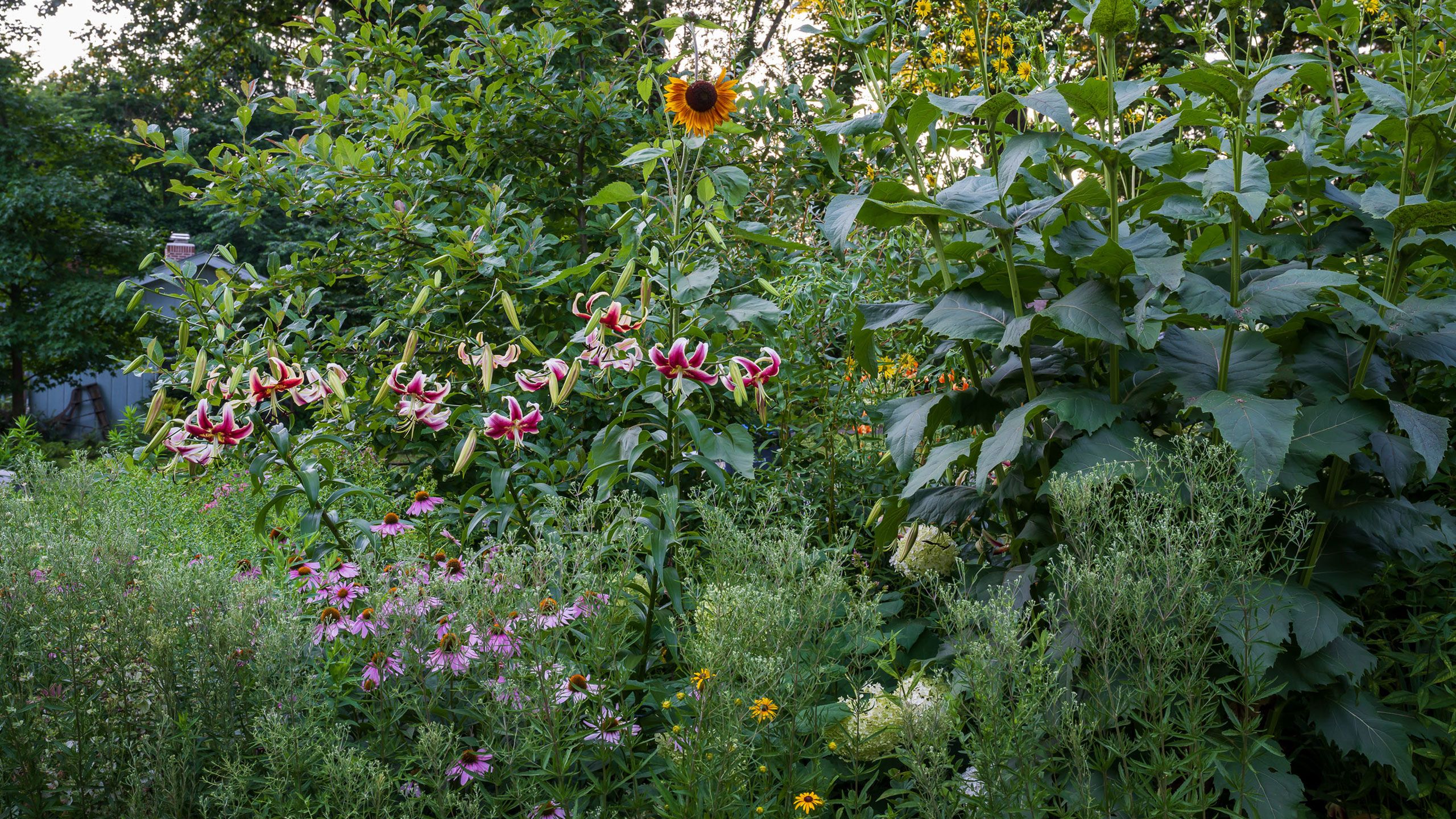
SEATING ARRANGEMENTS
While experts might spot the rare varieties, the most noticeable features of this landscape are the places where people can be found. At the sunny southeast corner of the house, the homeowners have created a gravel garden that features drought-tolerant plants, including hardy succulents and a few large agaves that they bring inside during the cold months. An espaliered fig tree adds a living sculpture to the wall, which is punctuated by shelves with potted plants. A low fieldstone wall surrounds the space, where the couple can sit at a small table and chairs to soak up the light themselves.
A few cushioned chairs beneath the dawn redwoods offer a cool seating area for resting in the shade. An excavation project for the house revealed massive granite boulders that now serve as a natural perimeter.
Nine years ago, the couple built a freestanding, screened-in room with a 180-degree view of the garden to give themselves a place to sit outside and eat meals sheltered from swarms of biting insects. The structure, now known as "El Forto," started as a sketch on a napkin. Then Benarcik built a model that they carried around until they figured out the right spot for the space.
“I didn’t want it to be fancy; I don’t need another house to clean,” Montgomery says. It’s a simple building that can be rinsed out with a hose, but it has electricity for lighting and room to seat a dozen or more people at a table. “If we have a party, it doesn’t matter how many people are present, everyone wants to eat in the fort,” she notes. “When our grandkids are here, they want to sleep outside in this room.” (For more details and views, check out the video below.)
JOINT EFFORT
While Montgomery and Benarcik enjoy entertaining and just spending time in their garden, you’re more likely to find them tending it. “When I come home from working in a garden all day, I eat dinner and then just want to get busy in our garden,” Benarcik says. “I probably should have my head examined.”
With all their know-how and enthusiasm, how do these two pros find common ground in their garden? “For the bigger projects, we collaborate, but in the day-to-day labors, we sort of break off and do our own thing,” Benarcik responds. “We both enjoy our private time, and working in the garden a few feet from each other on different tasks lets us have our time but not be apart. I like to say that we work in the garden ‘apart together.’”
“We often do an evening walk in the garden and say, ‘We should do this or do that,’ but we rarely ever follow through,” Montgomery adds with a laugh.
They also have fun trying out new ideas together. “We do a lot of installations for only one year and then see how they turn out,” she says. “Once we took more than 100 tillandsias (air plants), strung them on 10 different lines, and hung them from the dawn redwoods. You could barely see them until you got up close. It was kind of a wonder, a little fairy thing.”
None of this is to say they never disagree. “We give each other a little free rein,” Montgomery says. “For instance, I don’t think he likes annuals all that much and I grow quite a few violas.” She points to a border of Ophiopogon japonicus ‘Nana’ (a cultivar of dwarf mondo grass) she planted along recently installed hardscaping. “I think it really softens the lines of the stones and unites that area with a beautiful deep-green color,” she explains. She takes responsibility for winter protection by covering the plants with burlap. “They can get sunburned in the winter, leaving the tips of the leaves a light brown.”
They do share a philosophy that “everything green stays on the property.” When a tree must come down and it can be milled, Benarcik uses the wood to build unique furnishings, such as a large dining room table (that fits the entire family) and other furniture for their living room, bedroom, and guest room. “From a cherry tree, he made three big charcuterie boards that we used for our wedding,” Montgomery says. “One year he made our granddaughters jewelry boxes, and the boys got slingshots with mini marshmallows to shoot.” Montgomery cuts and brings in flowers for fresh bouquets and dries others for use throughout the offseason. “There’s never been a day without flowers in the house,” Benarcik says.
LOOKING AHEAD
As they grow older, the pair have begun to think about what’s next for them. “We’re going to start simplifying as we’re getting older,” Montgomery says. “We’ve also heard that other people do things on the weekends besides garden.”
In the summer of 2023, they spent a month in Croatia and Italy and realized that they don’t want to be permanently tied to their place. “At some point, we are going to walk away from this garden; we’re not going to try to take it with us,” Benarcik says. “So we have a lot of friendships with young horticulturists and are already giving away rare plants for their collections. When the time comes for us to leave, we’ll say, ‘Take our plants, or better yet, buy the place!’”
Scott Meyer is editorial director of GROW magazine. PHS members can participate in tours of amazing private gardens like this one. Get more details on membership benefits at https://phsonline.org/support-phs/membership.
COMING ATTRACTIONS
New gardening trends are always on the horizon, and experienced gardeners like Peggy Anne Montgomery and Dan Benarcik often see them first. We asked them to share what they’re most excited about these days.
BULB LAWNS “American homes tend to have big lawns, but they’re sterile,” Montgomery says. “In the Netherlands, I worked at these places that have tens of thousands, or even hundreds of thousands, of flowering bulbs in the lawn. Those first bulbs of the season are important pollen and nectar sources for the pollinators that emerge in spring. We planted the center of our front lawn with a mix of early blooming bulbs, and it was spectacular last spring. We left a 2-foot-wide frame of grass around the bulbs so the planting looked intentional. The neighbors who walked by seemed to think it was cool.” (Find out more about this trend in PLANT.)
MOSS GROUNDCOVER “When I started on this landscape, the trees were small,” Benarcik says. “As they’ve grown, we’ve been losing lawn to shade. At some point, I stopped fighting it and started to encourage the moss that began to show up. Moss is a different kind of aesthetic, and we like to see the grandkids take off their shoes and run around on it.”
Image: A band of mown grass around the bulb lawn makes the planting look intentional. Photo by Peggy Anne Montgomery.

Inner Beauty
INSPIRATION AND IDEAS FOR CREATING AN INDOOR GARDEN TO ENJOY IN ANY SEASON
photographs by ROB CARDILLO
A GARDEN IS NOT JUST A PLOT OF GROUND or a cultivated bed. A garden is anywhere you connect to nature through tending plants. For those who don’t have the space or the capability to grow outdoors, a collection of plants inside provides the opportunity to enjoy the health benefits that come with caring for them. In winter, houseplants allow all gardeners to keep their fingers pleasantly dirty while they wait for the return of warm weather.
In this photo gallery, you’ll see spiny succulents, big-leaved monsteras, blooming begonias, and a variety of other species. The settings range from a small shelf to a sunlit porch. The arrangements of the pots may be carefully composed or casually placed. As you scroll through these images, you can begin to imagine your own indoor garden.
For even more inspiration, visit the annual PHS Philadelphia Flower Show, where many extraordinary houseplants are on display individually and in collections. Be sure to check out the blue-ribbon winners in the Horticourt and sign up for one of the Potting Parties to get a plant you can bring home.
The next show will be March 2 to 10, 2024, and its theme will be United by Flowers. For tickets and more details, go to the Flower Show website.
Click on Photos Below
to Launch Gallery
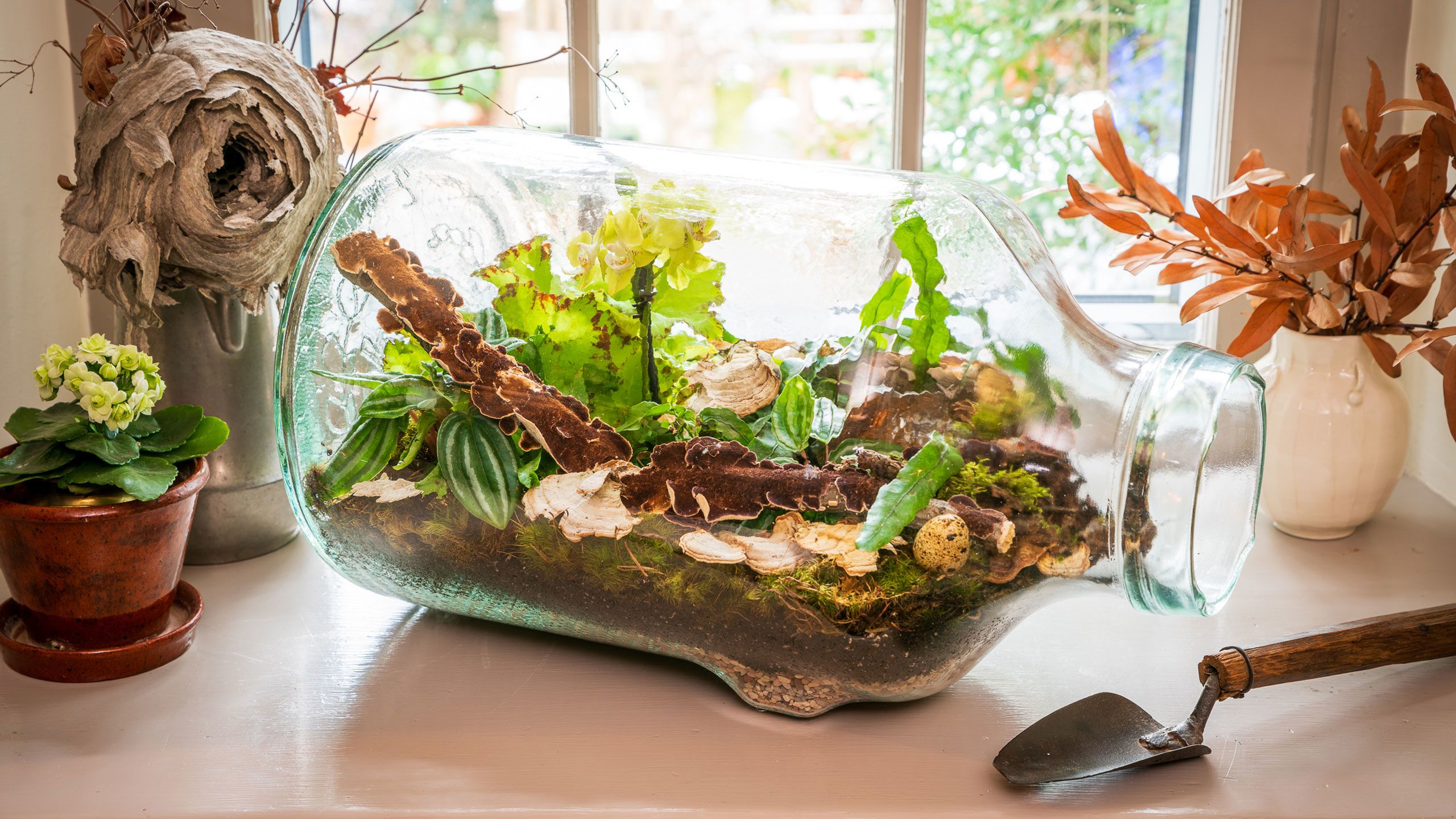
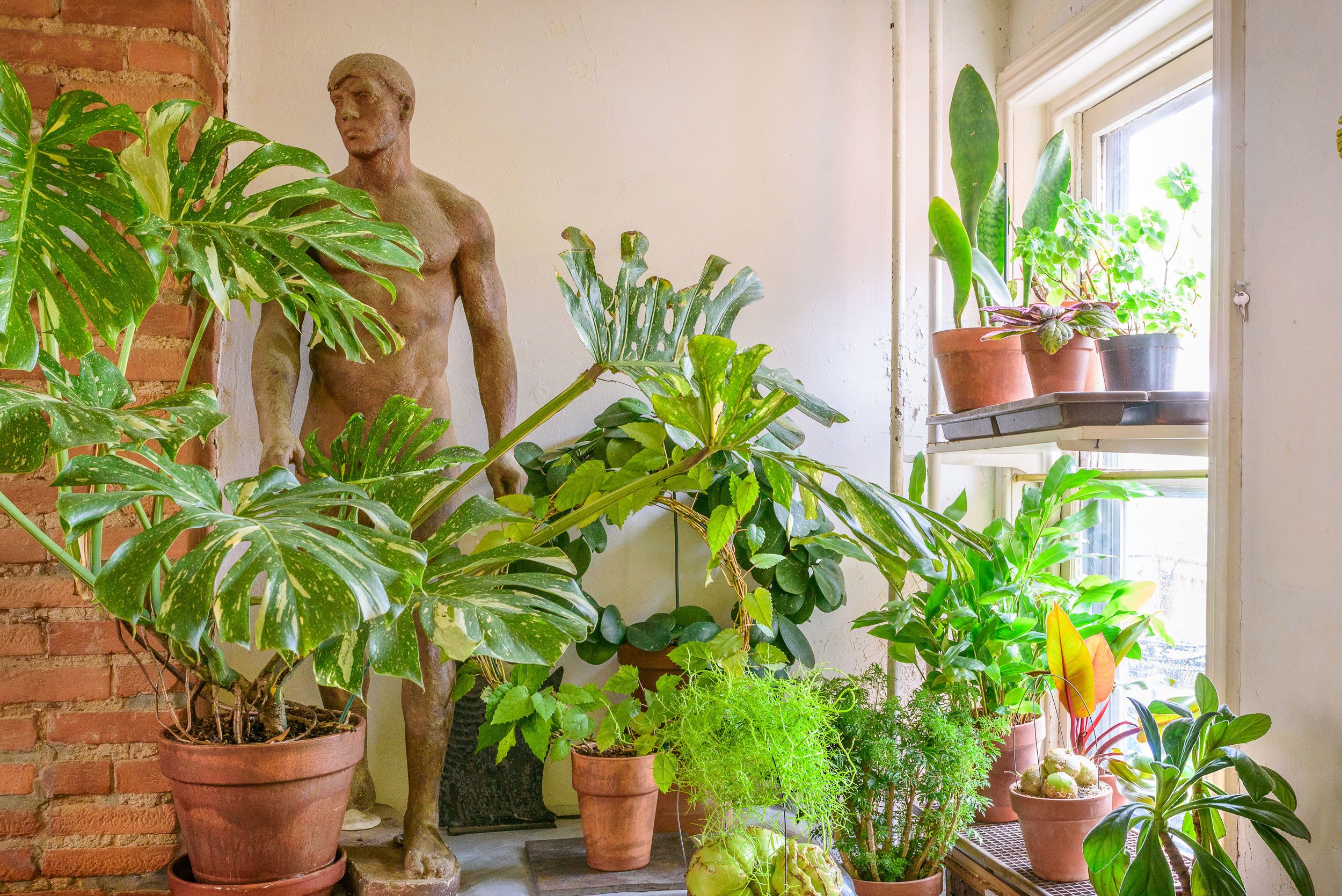
Monstera deliciosa ‘Cheesecake’, a large, variegated split-leaf philodendron, is one of the many prize-winning specimens that longtime Flower Show exhibitor Stephen Maciejewski grows in his three-story Philadelphia row home.
Monstera deliciosa ‘Cheesecake’, a large, variegated split-leaf philodendron, is one of the many prize-winning specimens that longtime Flower Show exhibitor Stephen Maciejewski grows in his three-story Philadelphia row home.
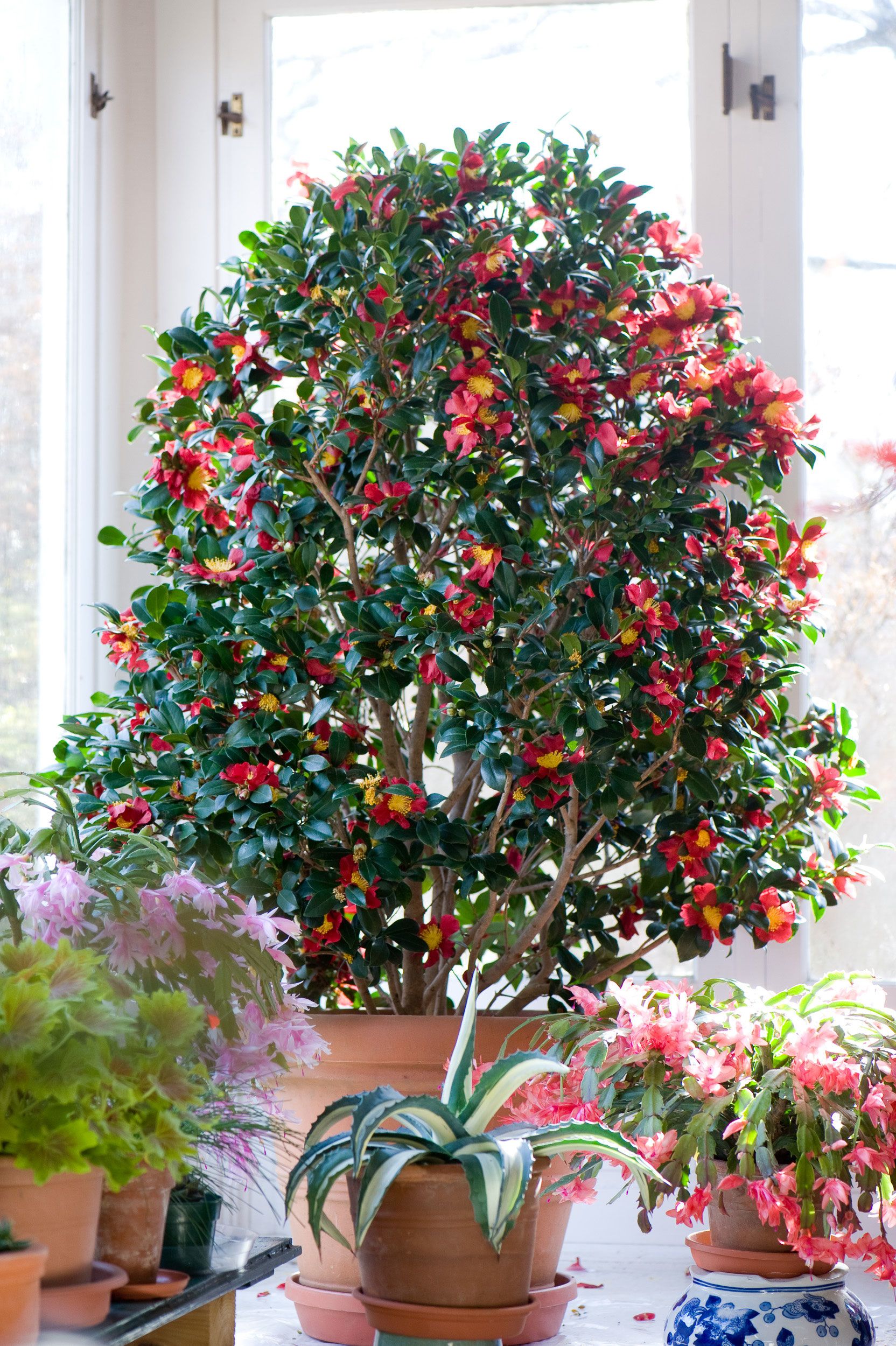
Camellia sasanqua 'Yuletide' blooms on the enclosed, unheated porch at the home of Adam Levine and Tom Borkowski in Media, Pennsylvania.
Camellia sasanqua 'Yuletide' blooms on the enclosed, unheated porch at the home of Adam Levine and Tom Borkowski in Media, Pennsylvania.
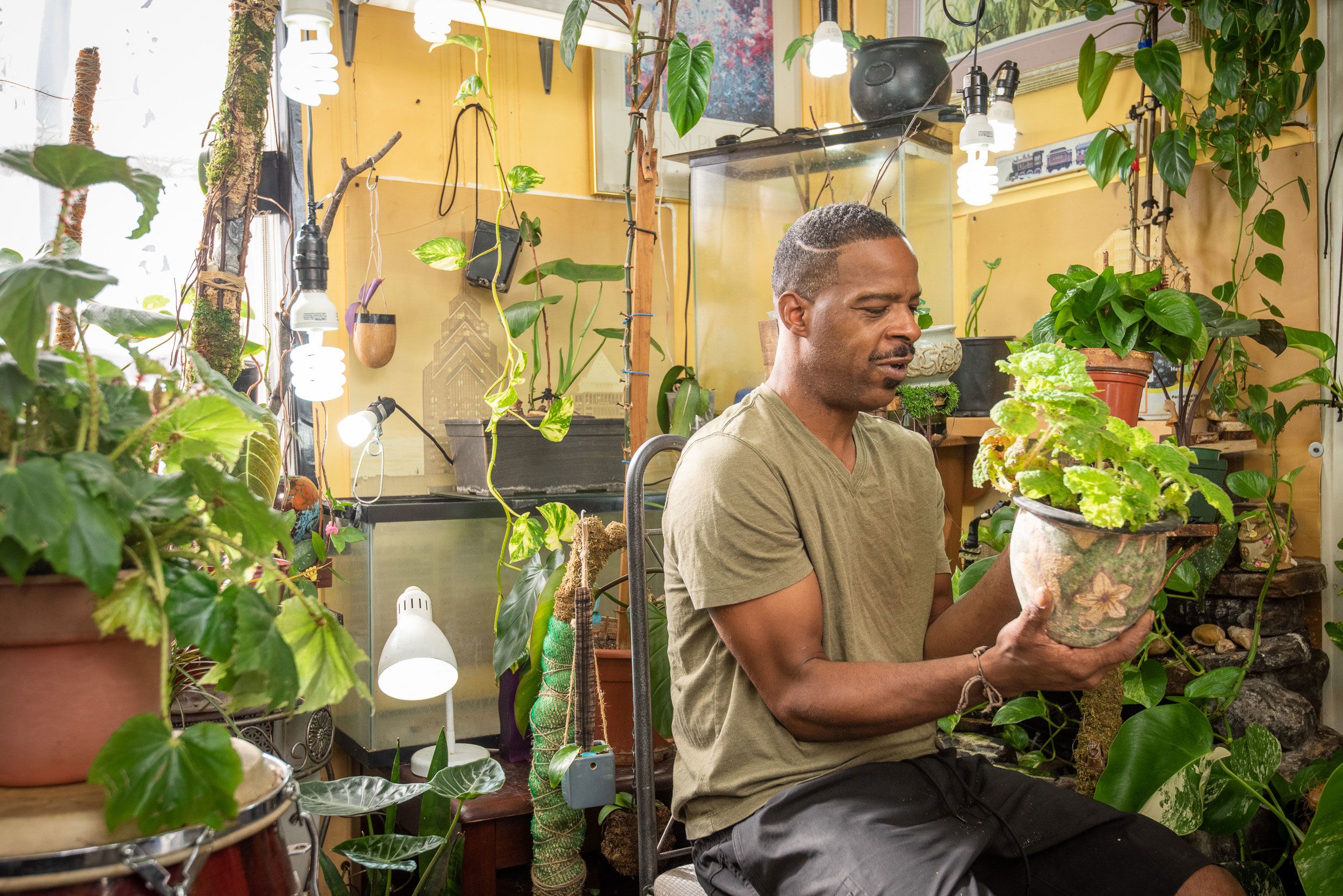
A variety of small lights keep the more than 200 uncommon houseplants growing in the Center City home of Nakia Maples, known on social media as the Philly Plant Guy.
A variety of small lights keep the more than 200 uncommon houseplants growing in the Center City home of Nakia Maples, known on social media as the Philly Plant Guy.
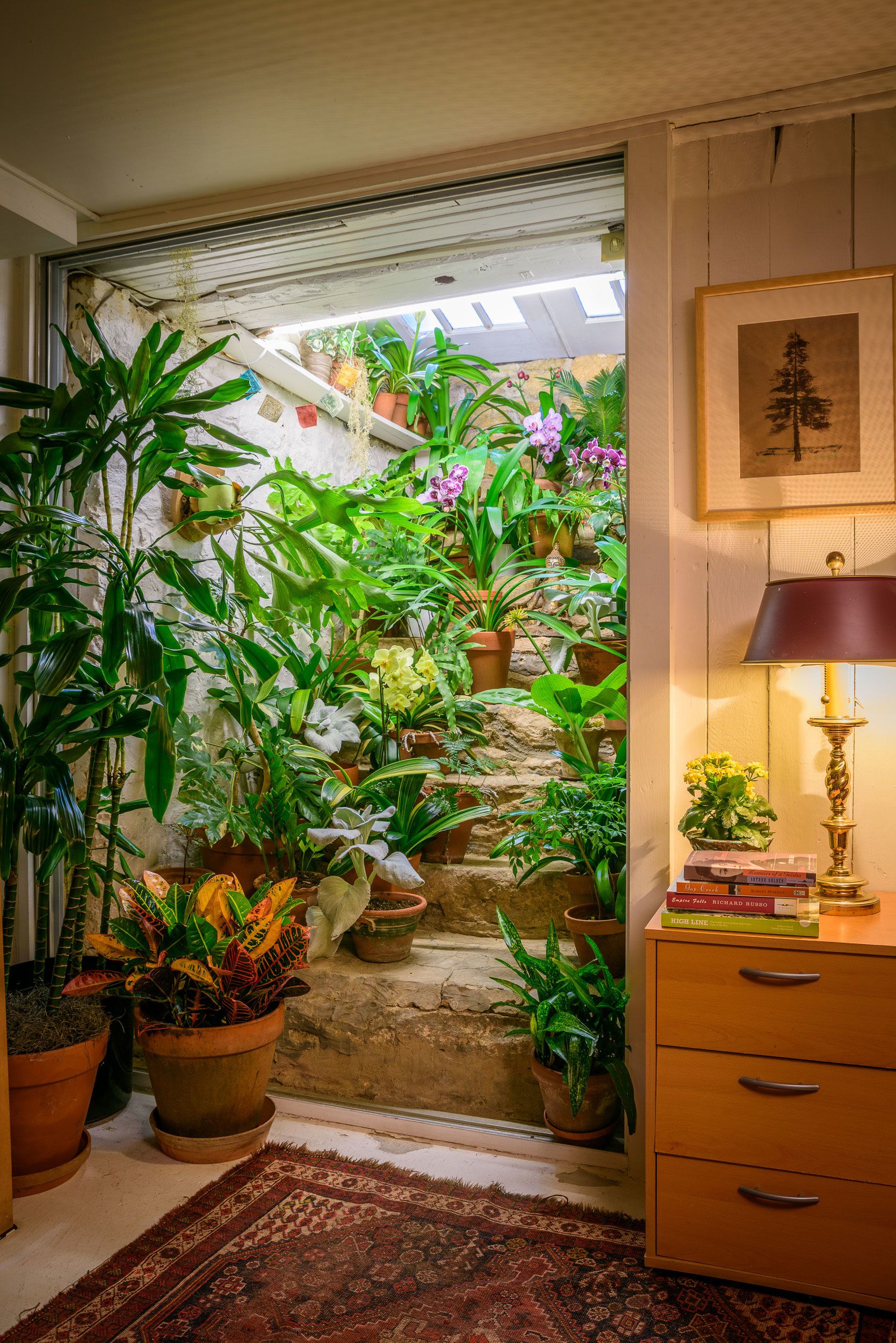
The basement stairs in the home of David Culp and Michael Alderfer become a platform for showcasing their collection of tender plants in the cold season.
The basement stairs in the home of David Culp and Michael Alderfer become a platform for showcasing their collection of tender plants in the cold season.
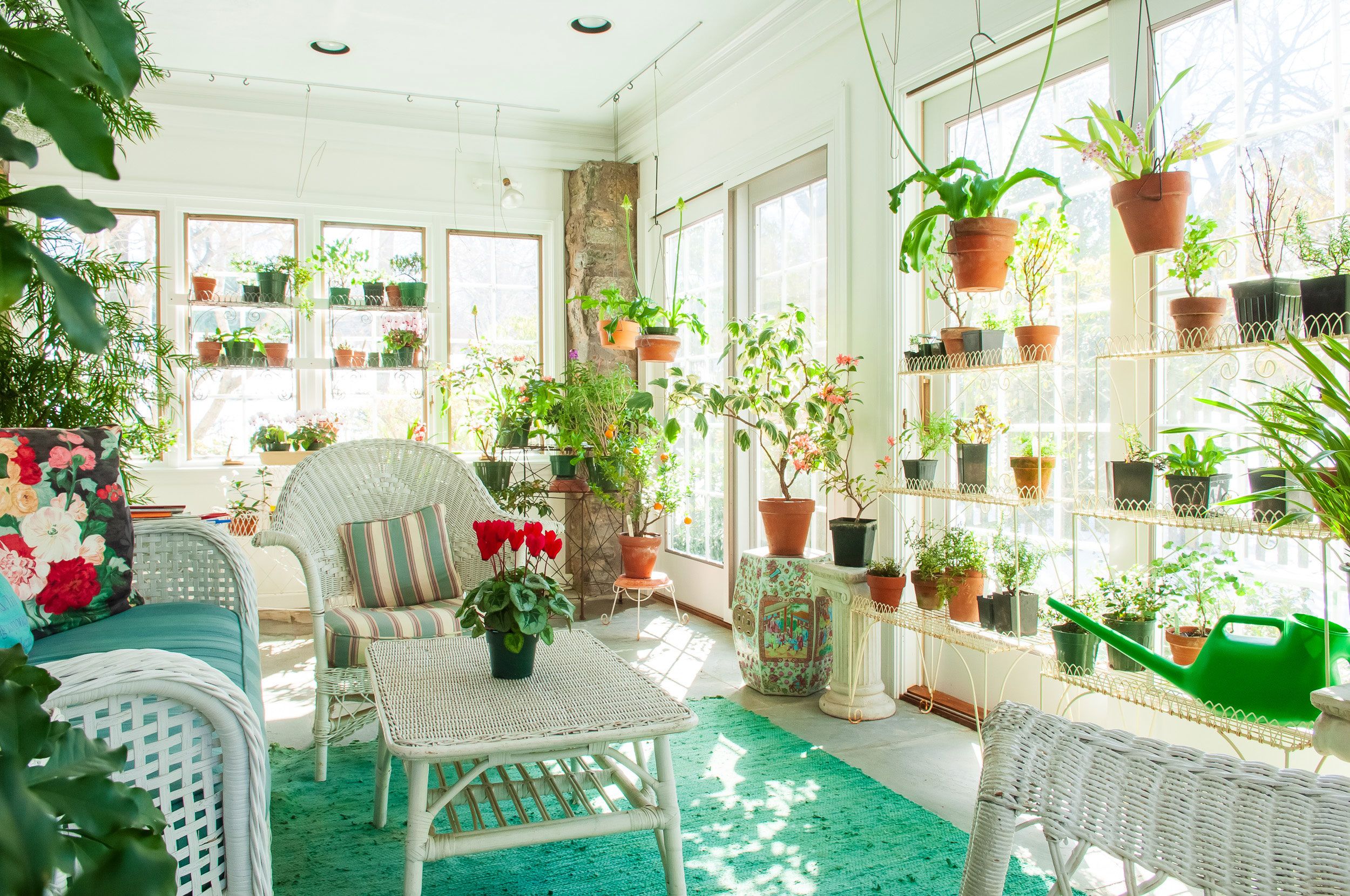
Peggy Bowditch’s Chestnut Hill sunroom offers plenty of space and light for her diverse collection of flowering, fruiting, and foliage plants.
Peggy Bowditch’s Chestnut Hill sunroom offers plenty of space and light for her diverse collection of flowering, fruiting, and foliage plants.
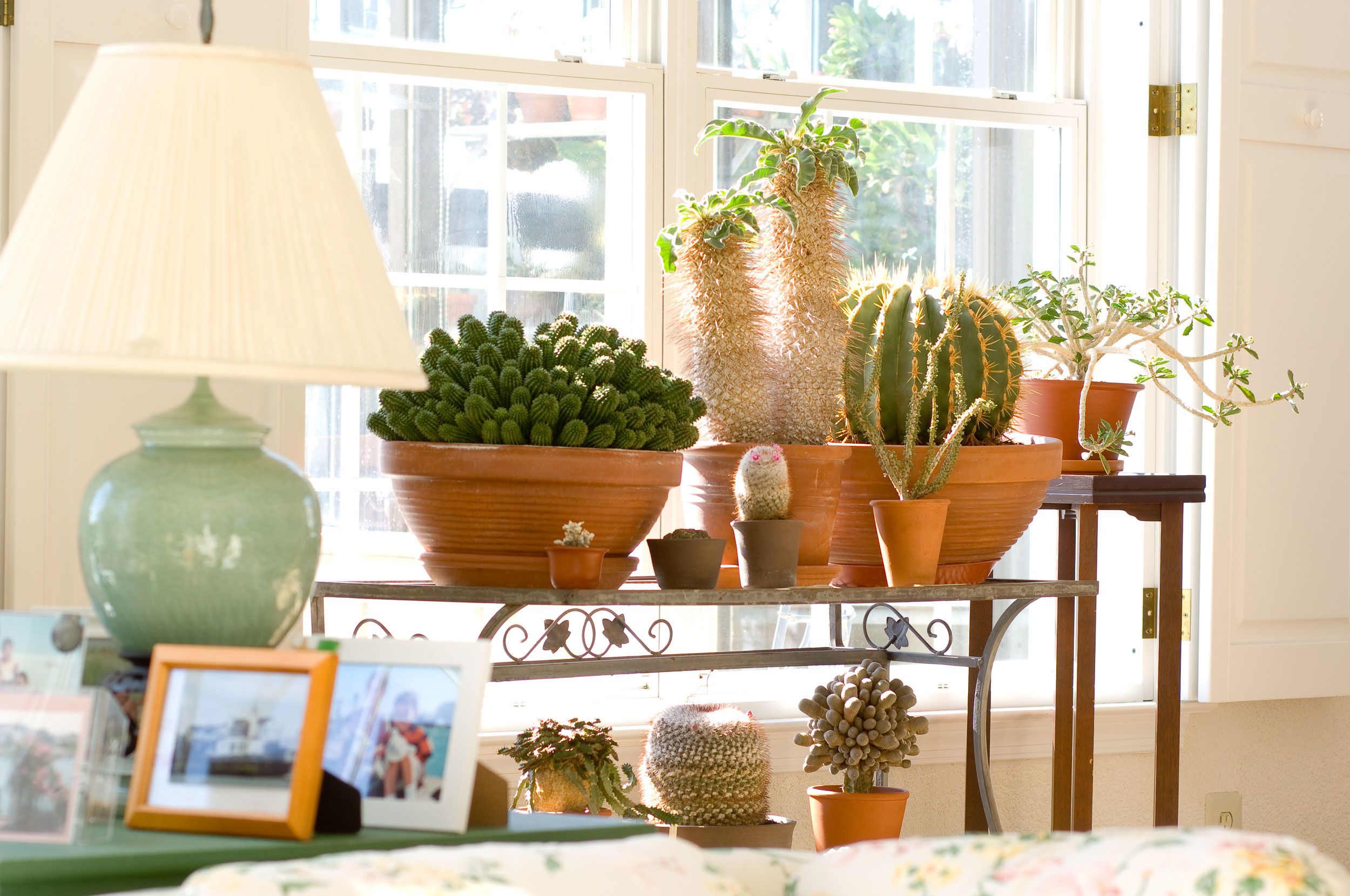
The late Sylvia Lin of Ambler, Pennsylvania, displayed her blue-ribbon-winning cactuses on a sunny windowsill.
The late Sylvia Lin of Ambler, Pennsylvania, displayed her blue-ribbon-winning cactuses on a sunny windowsill.
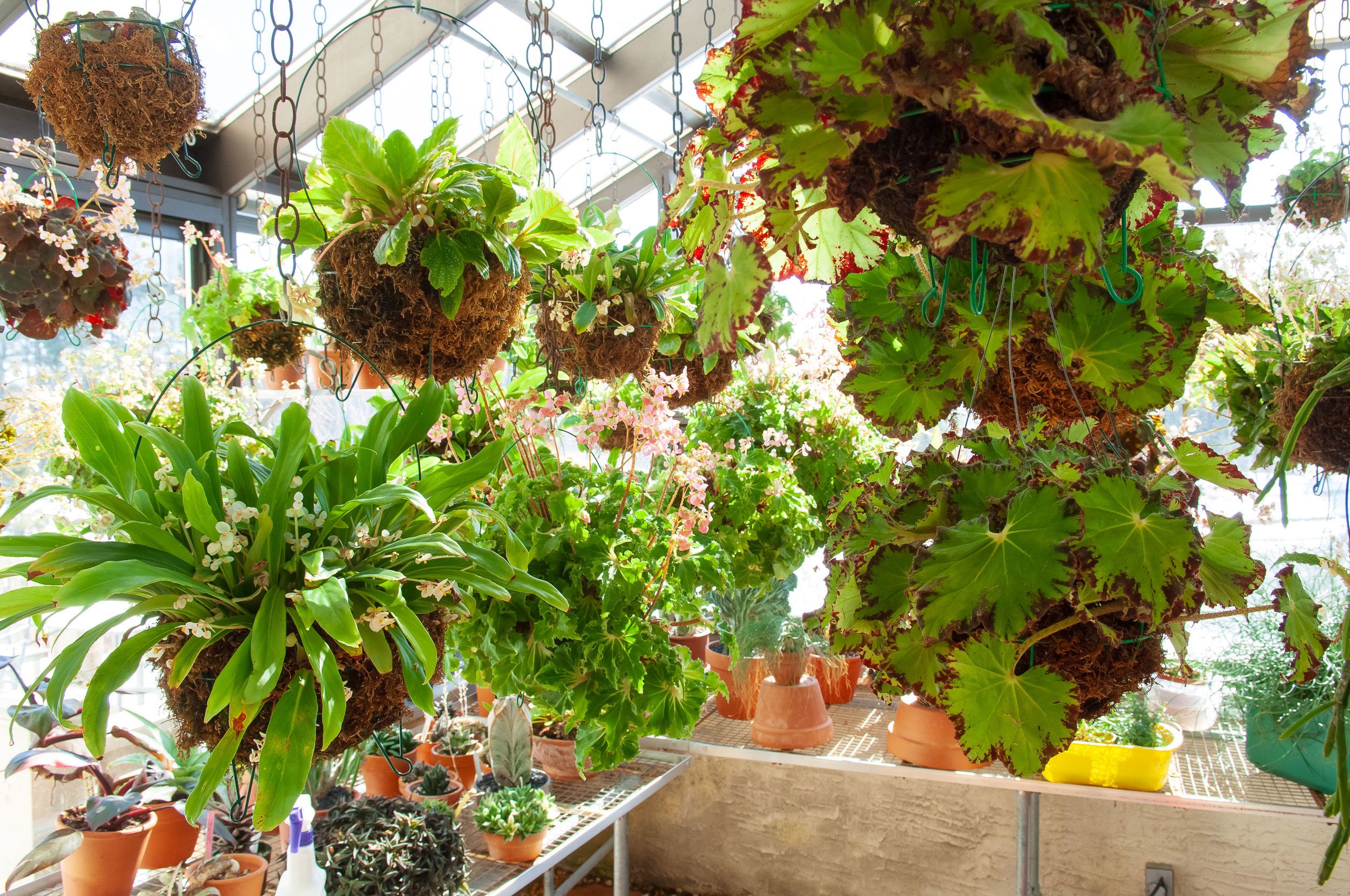
A mix of hanging begonias stayed warm and well-lit in the small greenhouse attached to Sylvia Lin’s home.
A mix of hanging begonias stayed warm and well-lit in the small greenhouse attached to Sylvia Lin’s home.

Great Gifts for
All Kinds of Gardeners
FRESH IDEAS FOR THE GREEN THUMBS AND PLANT-CURIOUS PEOPLE ON YOUR LIST.
BUYING HOLIDAY GIFTS FOR GARDENERS may seem easy because you know where to start, but not all gardeners are alike. To help you find the right presents for your family and friends, we asked Meredith Colberg Wysowski, PHS manager of event operations, to share some of her top picks from PHS Philadelphia Flower Show vendors. You can order them online and you can purchase them in person in the marketplace at this year’s show.
Click (+) below to see the perfect gift for each type of gardener on your list.

WHAT: The Best Hummingbird Feeder Ever
WHY: The 54 separate ports on this hanging feeder are sure to attract flocks of hummingbirds. You can refill the large 20-ounce reservoir by pouring water and sugar to the indicated levels, so there’s no need for outside measuring. The feeder comes in four colors that attract the little fliers: fuchsia, cobalt blue, purple, and red.
WHERE: KSCanuck
PRICE: $54.95

WHAT: Air Plant Jellyfish
WHY: Air plants are “epiphytes,” which means they do not need soil to grow but instead gather nutrients and moisture from the air. To make these home ornaments, the air plants’ tentacle-like foliage structures are paired with textural sea-urchin shells to create “jellyfish.” They are suspended by monofilament (fishing line), so they appear to be drifting in the ocean.
WHERE: Plants & What Knot
PRICE: $12 to $38, depending on size and style

WHAT: Ultimate Coco Garden Broom
WHY: Made from wood and naturally fallen coconut palm branches, this sweeper looks like a broom, but it works like a rake. You can use it to clean up leaves, twigs, and other debris on garden beds, pathways, and patios.
WHERE: Gardener’s Supply Company
PRICE: $44.99

WHAT: Seed-In Soil Digger
WHY: Planting an evenly spaced row of crops is much easier with this handy tool. It works like an old-fashioned dibble, which pokes holes in the soil with a tapered point. But this version has 17 points, so you can plant seeds or seedlings equidistantly from each other, helping you to get the most use from any garden space.
WHERE: Gardinnovations
PRICE: $25.95

WHAT: DIY Terrarium Kits
WHY: Creating a terrarium is one of the most popular activities at the Flower Show, and these kits have everything needed to try it at home. You get a glass container with cork lid, two 2-inch plants, moss, growing medium, tweezers, and more.
WHERE: Shady Exotics
PRICE: $15 to $30, depending on size

WHAT: Dirty Little Digger
WHY: This well-designed tool does so many different tasks that it takes the place of a bucket full of other implements. It can be used as a cultivator, trowel, scoop, weeding knife, and bulb digger. The head is made of stainless steel, and it can cut through roots, vines, and packed soil.
WHERE: Gardener’s Supply Company
PRICE: $24.99

WHAT: Growing Gardener’s 7-Piece Gift Set
WHY: Cultivate a love for gardening in kids ages 3 to 8 with this fun and practical starter set. The tools have metal heads and wooden handles, so they’re sturdy enough for digging and scratching in the soil. Kid-size gloves complete the kit.
WHERE: Gardinnovations
PRICE: $19.95

WHAT: Three recent books, including “In Search of the Old Ones: An Odyssey Among Ancient Trees,” by Pennsylvania author Anthony D. Fredericks; “The Ultimate Flower Gardener’s Guide,” by Jenny Rose Carey; and “Private Gardens of Philadelphia,” by Nicole Juday with images by “GROW” magazine’s photography director, Rob Cardillo.
WHY: Each of these offers information and inspiration to gardeners.
WHERE: Support local bookshops in person or through Bookshop.org
PRICE: $25.99 to $55.80, depending on the book

WHAT: PHS membership
WHY: PHS members get discounts on Flower Show tickets and workshops, invitations to special members-only programs and garden tours, discounts at local nurseries, and a subscription to GROW magazine! Most important, members help support the effort to bring the benefits of gardening to communities throughout our region.
WHERE: PHS website
PRICE: Basic membership starts at $50, with benefits increasing at higher levels
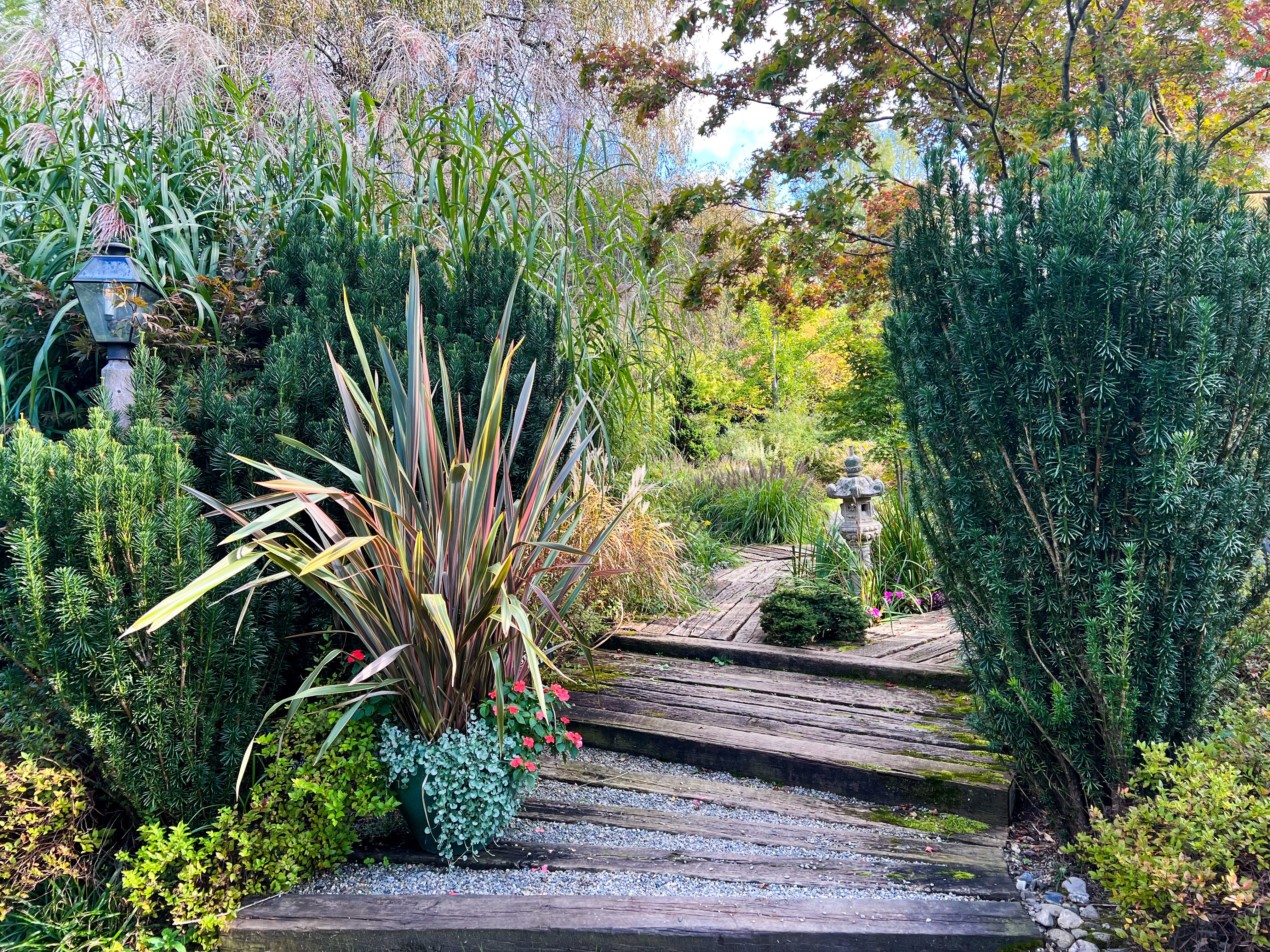
Above: In any season Paxson Hill showcases native plants and uncommon varieties of trees, shrubs, grasses, and more.

Paxson Hill Farm
NEW HOPE, PENNSYLVANIA
WHY VISIT?
Whether you’re an enthusiastic plant nerd or a nature lover, or if you’re just looking for a fun place to spend time outdoors with your family, Paxson Hill Farm offers you a variety of opportunities to be awed, inspired, and amused. Set among rolling hills and wooded estates, this off-the-beaten-path destination in Bucks County is a unique landscape featuring rare plants, a diverse array of thoughtfully designed gardens, and an art collection that ranges from structural to whimsical. The 30-acre property has more than 200 different species of trees and shrubs, earning it accreditation as a certified arboretum and making it rich in color and interest year-round. People of all ages will be charmed by the menagerie of animals housed on the farm. You can spend an hour or two, or a whole afternoon, discovering surprises in every nook and cranny.
THE BACKSTORY
Before 1997, the property had been owned by a corporate executive who used the front lawn as a runway for his private plane. A few trees were the only plants around the house when Bruce Gangawer and his partner bought the place that year. Gangawer, an architect and a landscape designer, brought his years of experience tending gardens around the United States and in Europe and his passion for horticulture to the task of transforming this personal space into a public attraction. A self-described plant addict, he began creating distinctive gardens in each of the microclimates on the property.
In 2000, “I started a nursery here because I couldn’t find what I wanted,” Gangawer says. “I had to grow it for myself.” (He also designs and maintains many private gardens in the area.) The nursery soon opened for wholesale and then retail business, and before long, curious visitors were permitted to stroll through the adjoining gardens. The site has since hosted weddings, art shows, corporate events, and group tours, along with countless individuals and families.
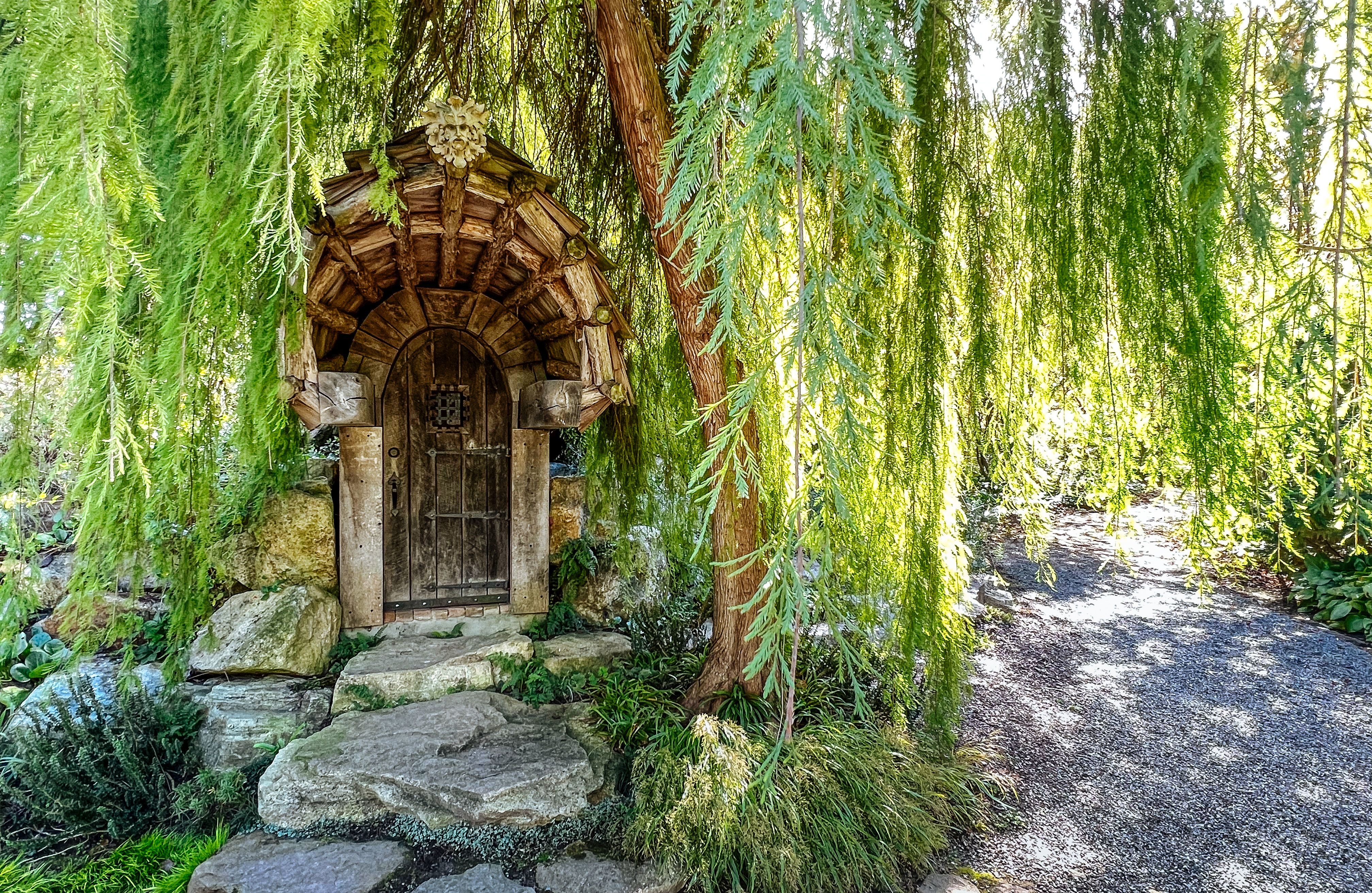
Adding a handmade door to a root cellar created the Hobbit House, which shelters a sculpture that captures sunlight beaming in from the outside.
Adding a handmade door to a root cellar created the Hobbit House, which shelters a sculpture that captures sunlight beaming in from the outside.
THE HIGHLIGHTS
Four seasons. These gardens have been planned for viewing in all seasons, so you can find captivating color and form whenever you visit. On a recent cool autumn day, camellias were in bloom, towering grasses with white seedheads swayed in the breeze, and the foliage of Japanese maples glowed in pink, orange, and gold. In winter, the textures of the many species of conifers and the graceful shapes of trees keep the gardens interesting. Spring and summer bring a show of blooms that changes from one week to the next, Gangawer says.
Photo ready. The spot most likely to be used for taking selfies is the large stone moon gate at the entrance to the Temple Garden. It is dramatic on its own, but it also serves as a lens through which you can take in the long view of the area that is lined with trimmed hedges and punctuated with specimen trees and features a large, bubbling fountain at its center.
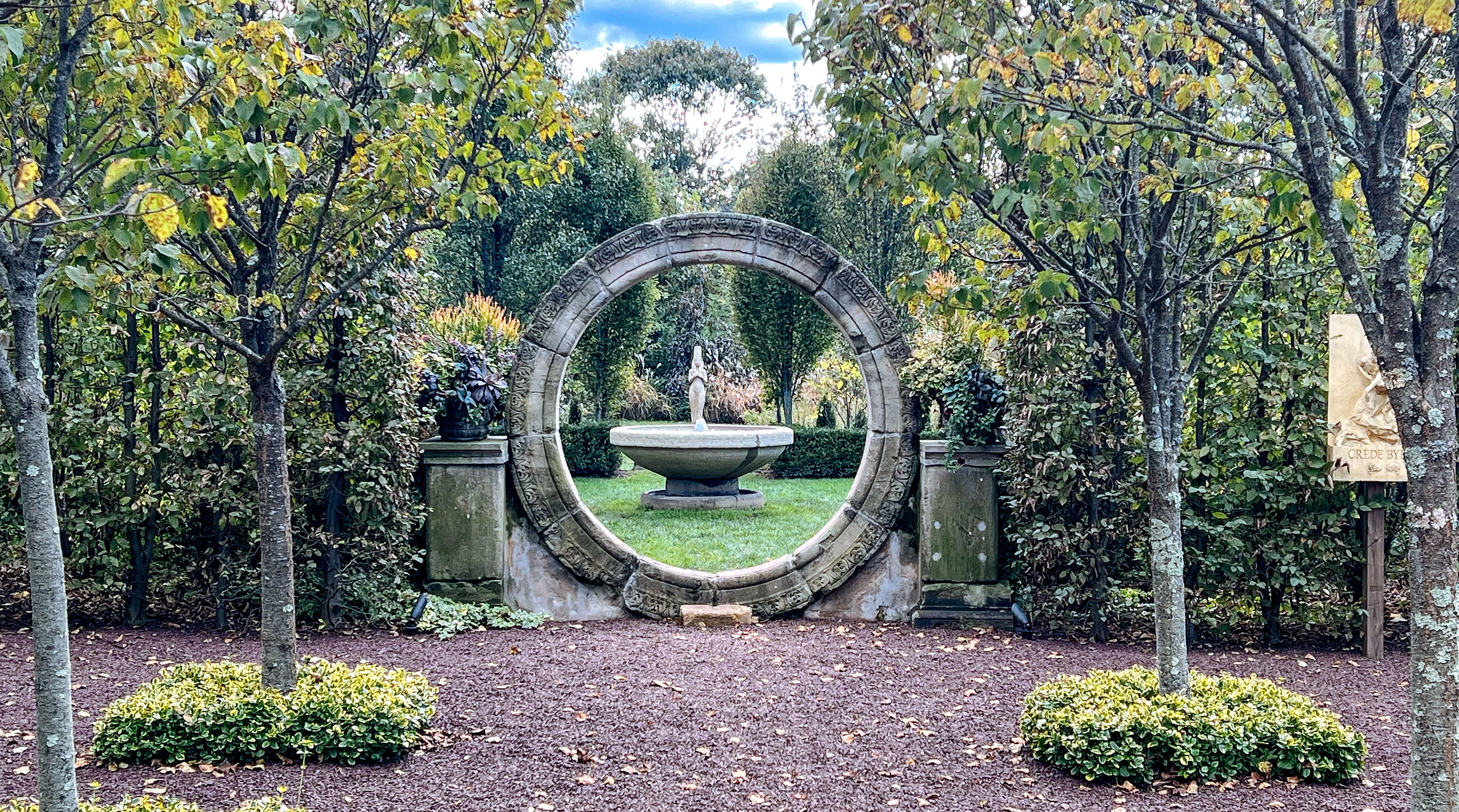
A moon gate serves as entrance to the Temple Garden and a lens through which to view it.
A moon gate serves as entrance to the Temple Garden and a lens through which to view it.
Garden variety. Follow the path and you’ll pass through several different environments, each planted in layers from groundcovers to trees. Among the unique spaces are shady areas and formal alleys, a natural amphitheater, and a swamp garden where you can see a bronze hippopotamus that was once on display at the Philadelphia Zoo. The path through the Bridge Garden takes you over a pond full of koi and other fish and then past a root cellar that’s now known as the Hobbit House. In almost every direction you turn, you see the sculptures—big and small, abstract and realistic—that Gangawer has gathered. “I get a little silly sometimes with the artworks,” he says, “but kids seem to really love them.”
A maze. Beyond the nursery beds, Gangawer has planted a shrubbery maze that leads to a gazebo in the center. It’s challenging and it’s not just for kids!
Animal attraction. Along with amassing plants and art, Gangawer has been assembling a collection of creatures at Paxson Hill Farm. Miniature donkeys frolic along with a small herd of sheep, goats, and alpacas. Mute swans glide around one of the many fish-filled ponds. Peacocks and silver pheasants strut and preen in large pens, their dramatic plumage on display for everyone to see. “Almost all of the animals are rescues,” he notes.
“Somehow people find me with these animals that need a home, and we take them in here.”
—Bruce Gangawer, garden designer
Shopping opp. The full-service nursery on-site offers trees, shrubs, perennials, annuals, succulents, and tropicals. “If you’re looking for a plant that’s hard to find, we probably have it here,” Gangawer says. In the cold season, the greenhouse also shelters dozens of containers with tender plants that belong to his clients and are returned to their homes in spring. The nursery is the perfect end to your visit, and if you want Gangawer to bring his talents for landscape design to your garden, it’s the place to meet him.
IF YOU GO
Paxson Hill Farm (3265 Comfort Rd., New Hope, PA; 215-297-1010) is open daily from March 14 through December 23. Hours are 9 a.m. to 5 p.m. Monday through Saturday and 10 a.m. to 5 p.m. Sundays. Entry costs $10 per person (no charge for children 5 years old and under). Call to arrange a group tour and special events on the site. Get all the details.

9 Garden-Worthy Varieties
EVERY YEAR, NURSERIES, CATALOGS, AND WEBSITES tout new plant varieties with promises of better performance, exceptional colors and forms, and resistance to common problems. The PHS Gold Medal Plant Award committee evaluates recent introductions over several years for their appearance, ease of cultivation, multiple seasons of interest, value to wildlife, and more. The winners can all be found in the PHS Gold Medal Plant database.
To help you find more choices for your garden, we asked a few local horticulture pros to tell us about new plants that have impressed them. We’ve included online sources where possible, but you’ll find most, if not all, of these varieties in our region’s well-stocked nurseries.
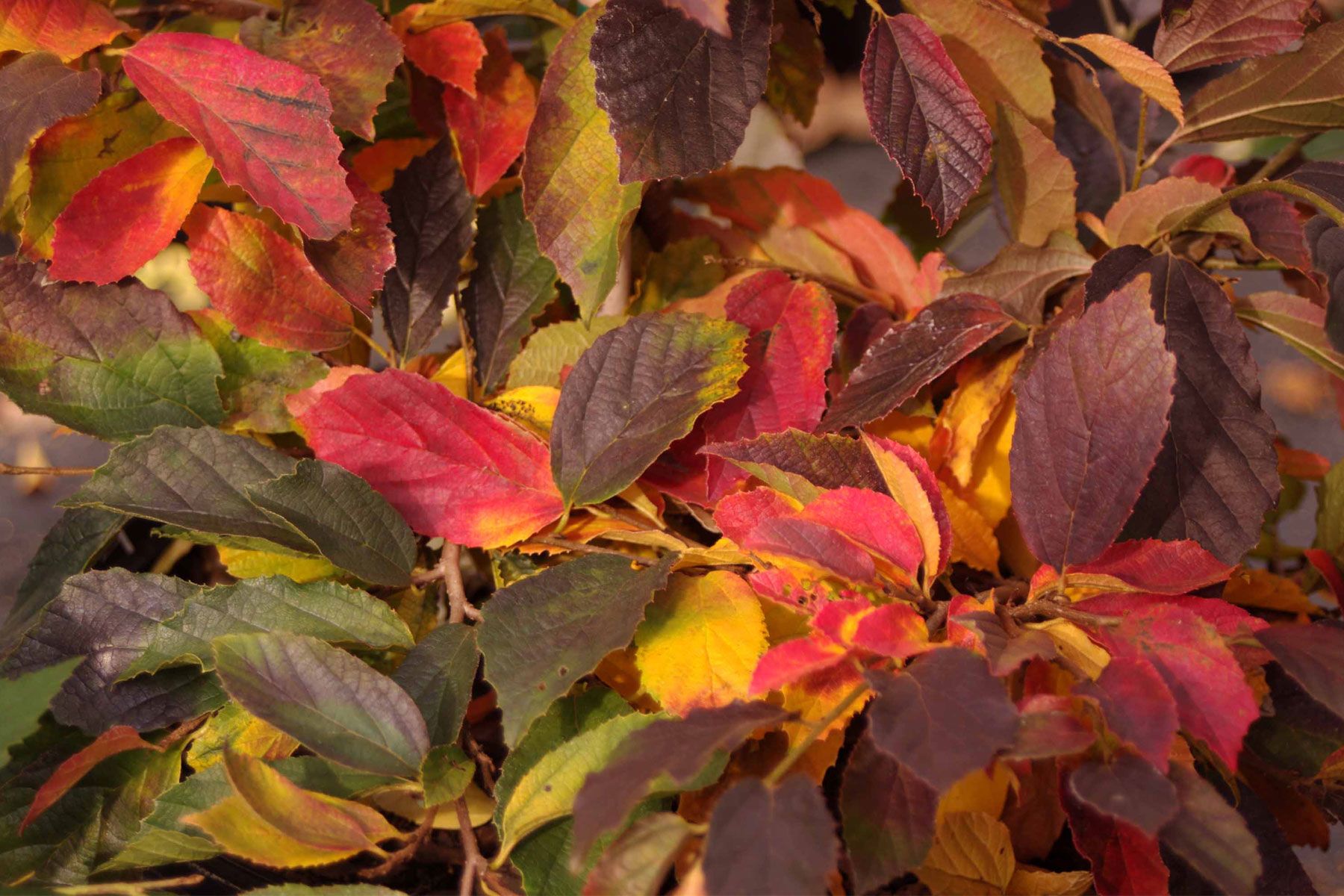
Photo by Lisa Strovinsky/Pleasant Run Nursery
Colorful Tree
Parrotia subaequalis (Chinese ironwood) is a new species of parrotia and new tree introduction. “It is a small-to-medium-size tree with dazzling purple fall foliage,” says Andrew Bunting, PHS vice president of horticulture.
Source: Pleasant Run Nursery
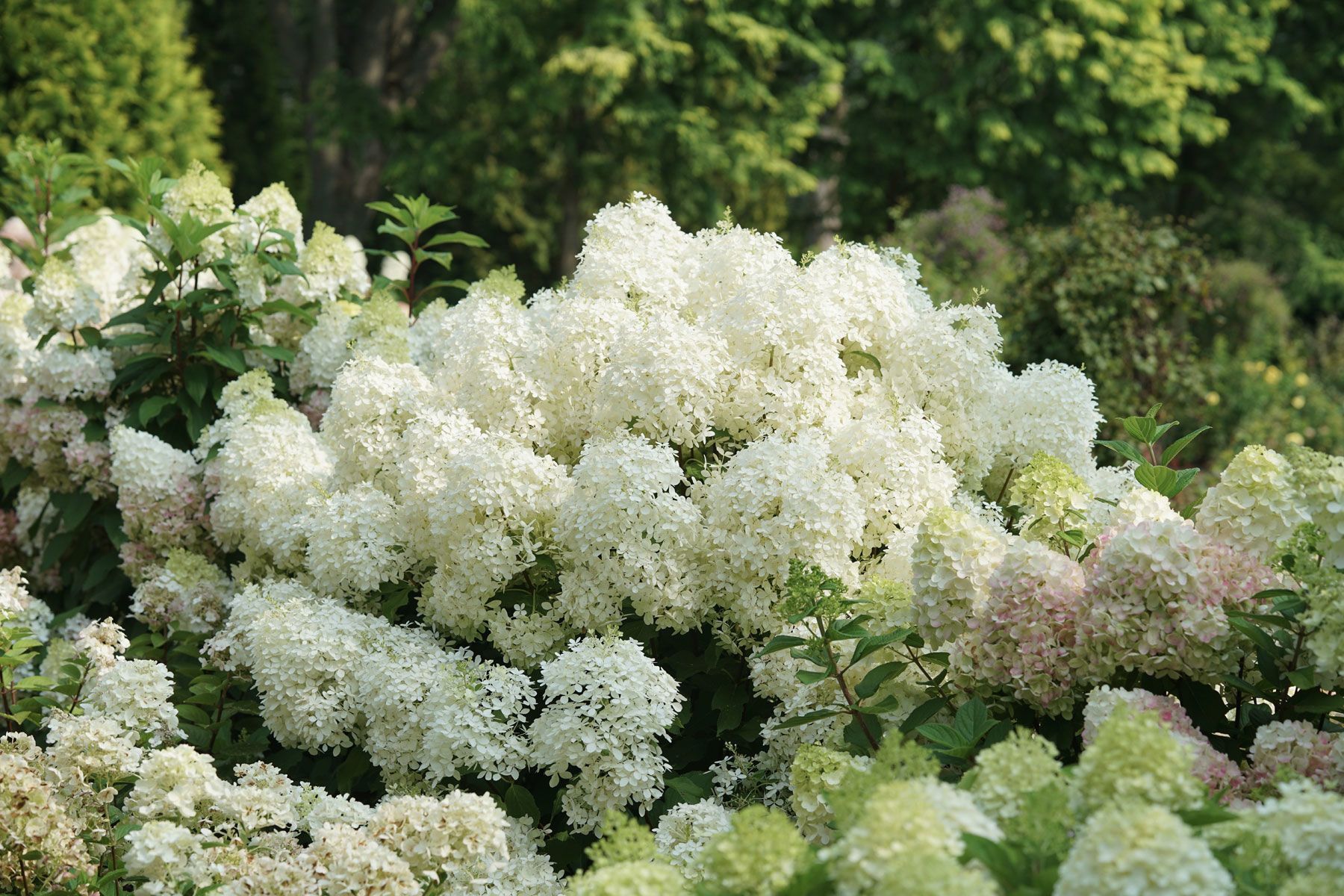
Photo by Proven Winners Color Choice
Dwarf Hydrangea
If you love the abundant blooms of panicle hydrangea (Hydrangea paniculata) but have limited space in your garden, Bunting recommends Puffer Fish®, a new dwarf version. This shrub grows about 3 to 5 feet tall and wide and is engulfed in fluffy white blooms from mid to late summer.
Source: Proven Winners Direct
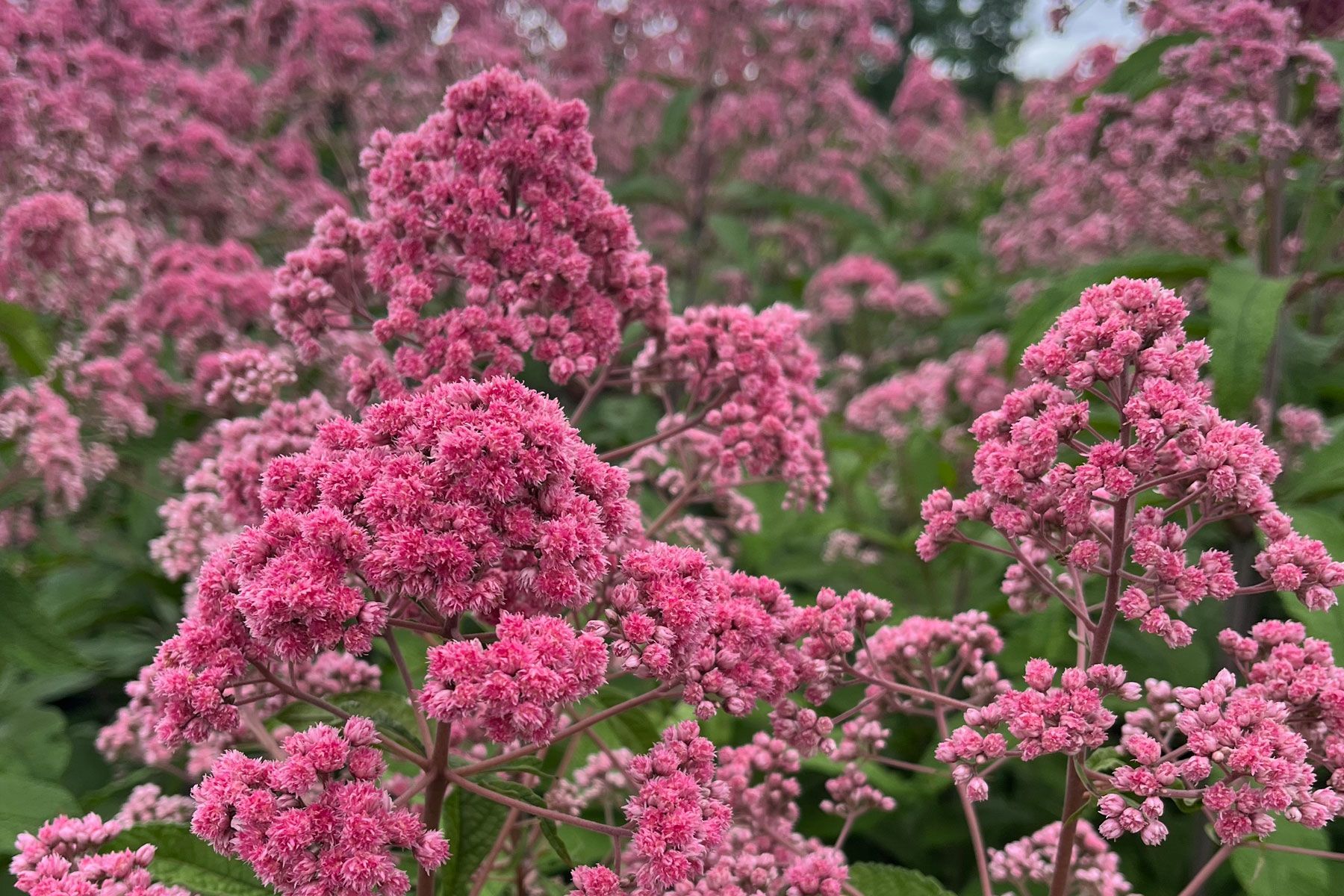
Photo by Kind Earth Growers
Compact Native
Eutrochium fistulosum ‘JoJo’ is a container-ready cultivar of Joe Pye weed, a native perennial with vibrant-pink, double flowers that bloom for weeks in late summer. Like other Joe Pye weed varieties, ‘JoJo’ is a valuable resource for many types of pollinators, but it tops out at 3 to 4 feet tall rather than 6 feet as others do. It was discovered at Kind Earth Growers in Ottsville, Pennsylvania, and it’s already a favorite of Sharee Solow, a renowned garden designer in the region.
Source: Izel Native Plants
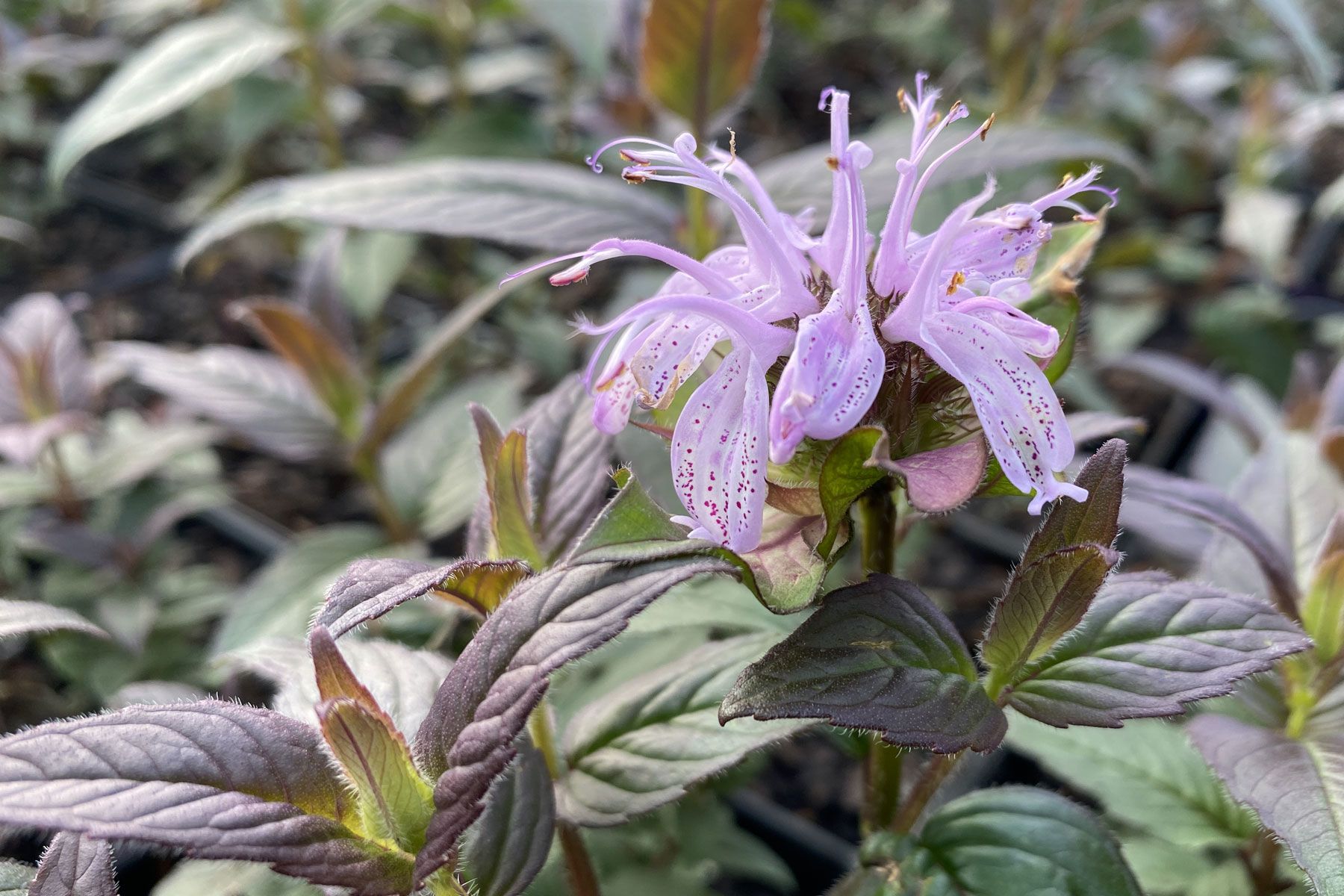
Photo by Brent Horvath
Bee Feeder
Monarda bradburiana ‘Midnight Oil’ has glossy, deep-burgundy foliage early in the season and fluffy lavender blooms in mid to late summer. The long-lasting color of the foliage acts as a season extender, says Leah Blanton, PHS design and procurement manager. She used it in containers of native plants installed around the Pennsylvania Convention Center, home to the PHS Philadelphia Flower Show. This eastern bee balm is shorter and less aggressive than standard bee balm types, yet it still attracts throngs of bees, butterflies, and hummingbirds.
Source: Avant Gardens
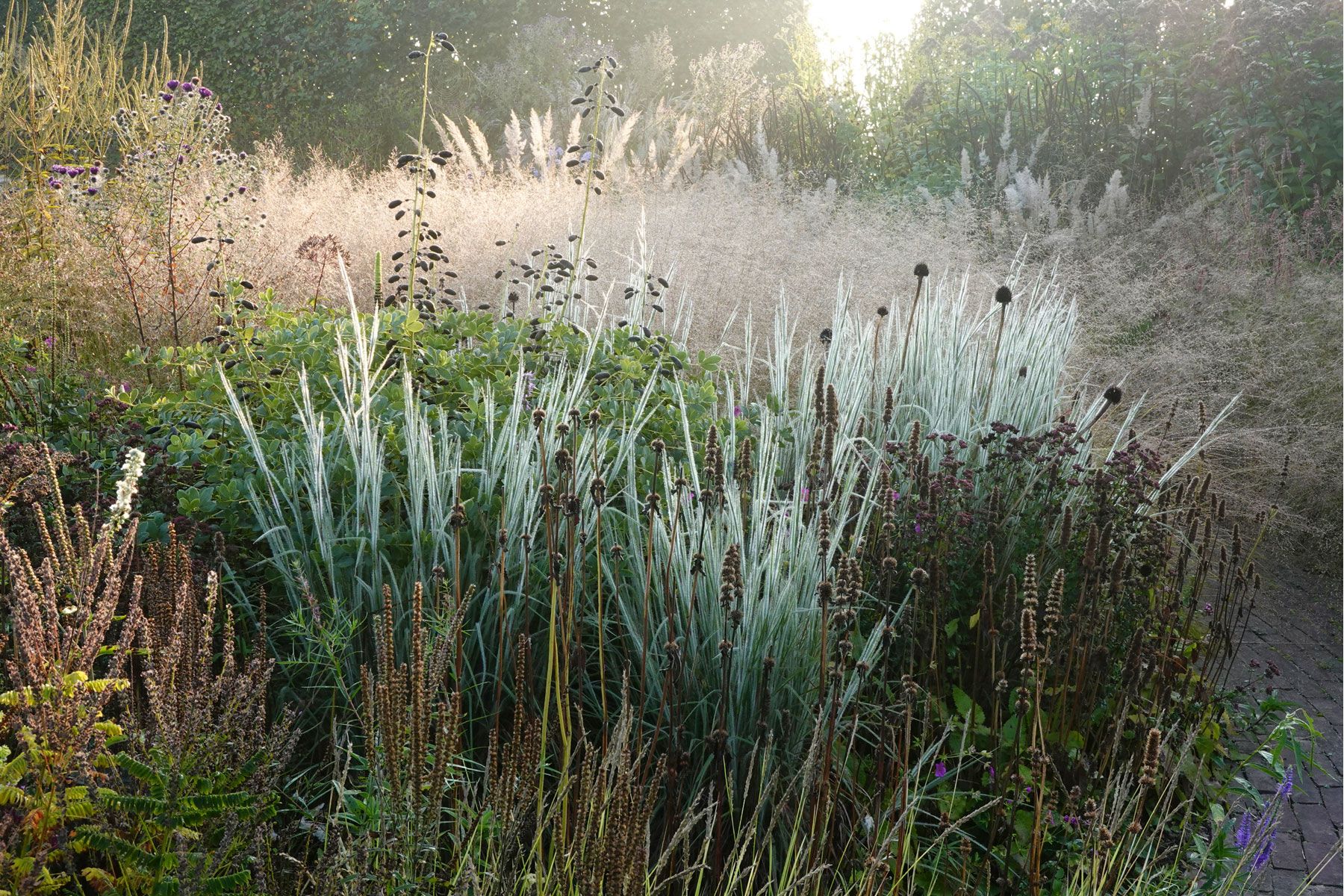
Photo by Piet Oudolf
Fresh Grass
Schizachyrium scoparium ‘Ha Ha Tonka’ is an ornamental grass from Piet Oudolf, a trendsetting landscape designer, and plantsman Cassian Schmidt. The foliage of this cultivar of little bluestem is bluish green with hints of red, pink, and orange, Bunting says. The leaves have dense, fine hairs that catch sunlight and create a glowing effect.
Source: Check local nurseries in spring 2024.
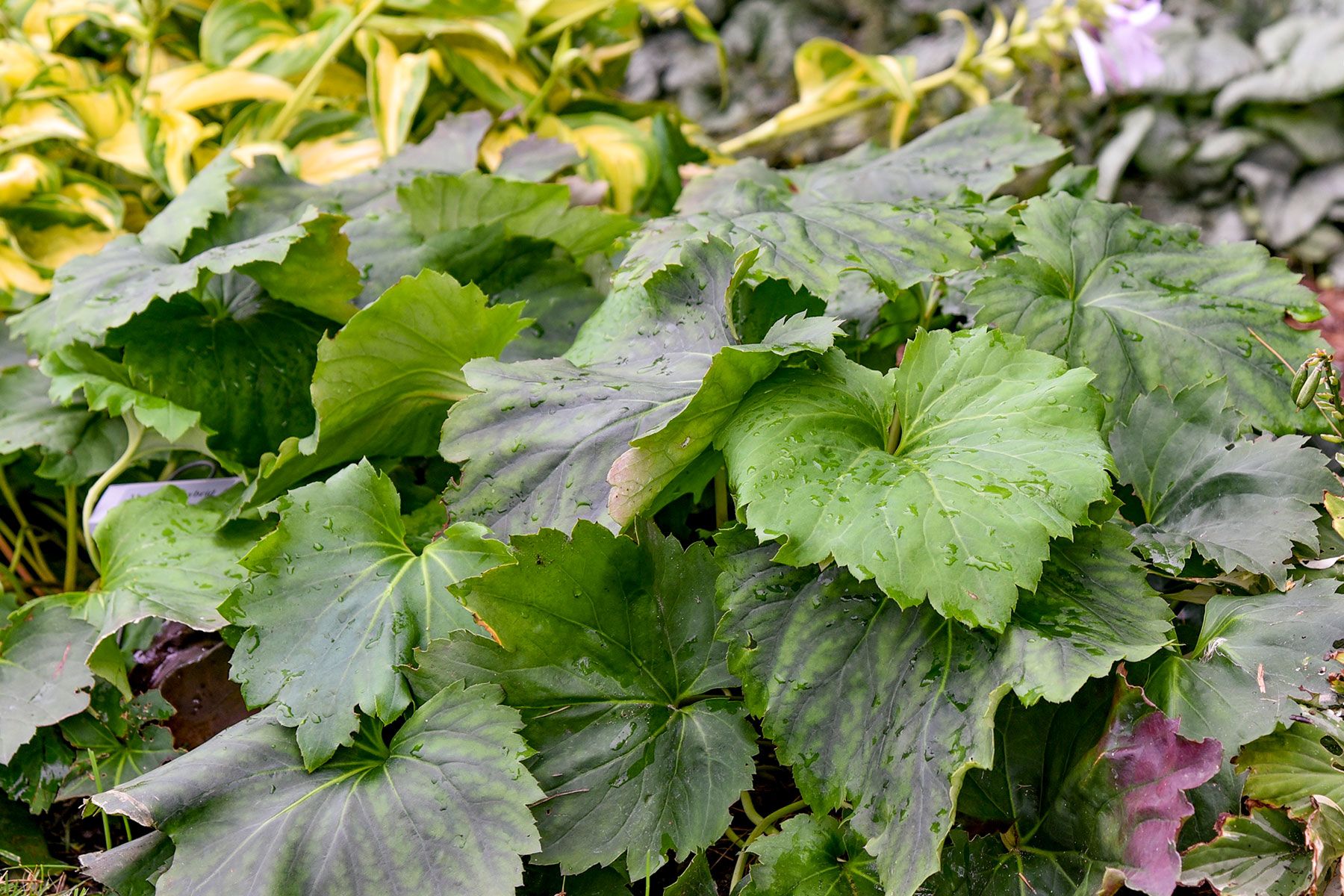
Photo by Walter’s Gardens
Fiery Foliage
“On my list this year for my small shade garden is xOrdedenia ‘Fusion of Fire’,” Solow says. This perennial is an all-new combination of two plants from the genera Mukdenia and Oresitrophe. It has large, 12-inch-diameter leaves with notched edges, and spikes of white flowers rise above the mound of foliage in spring. ‘Fusion of Fire’ becomes a real showstopper in fall when the huge leaves turn brilliant red.
Source: New Hampshire Hostas
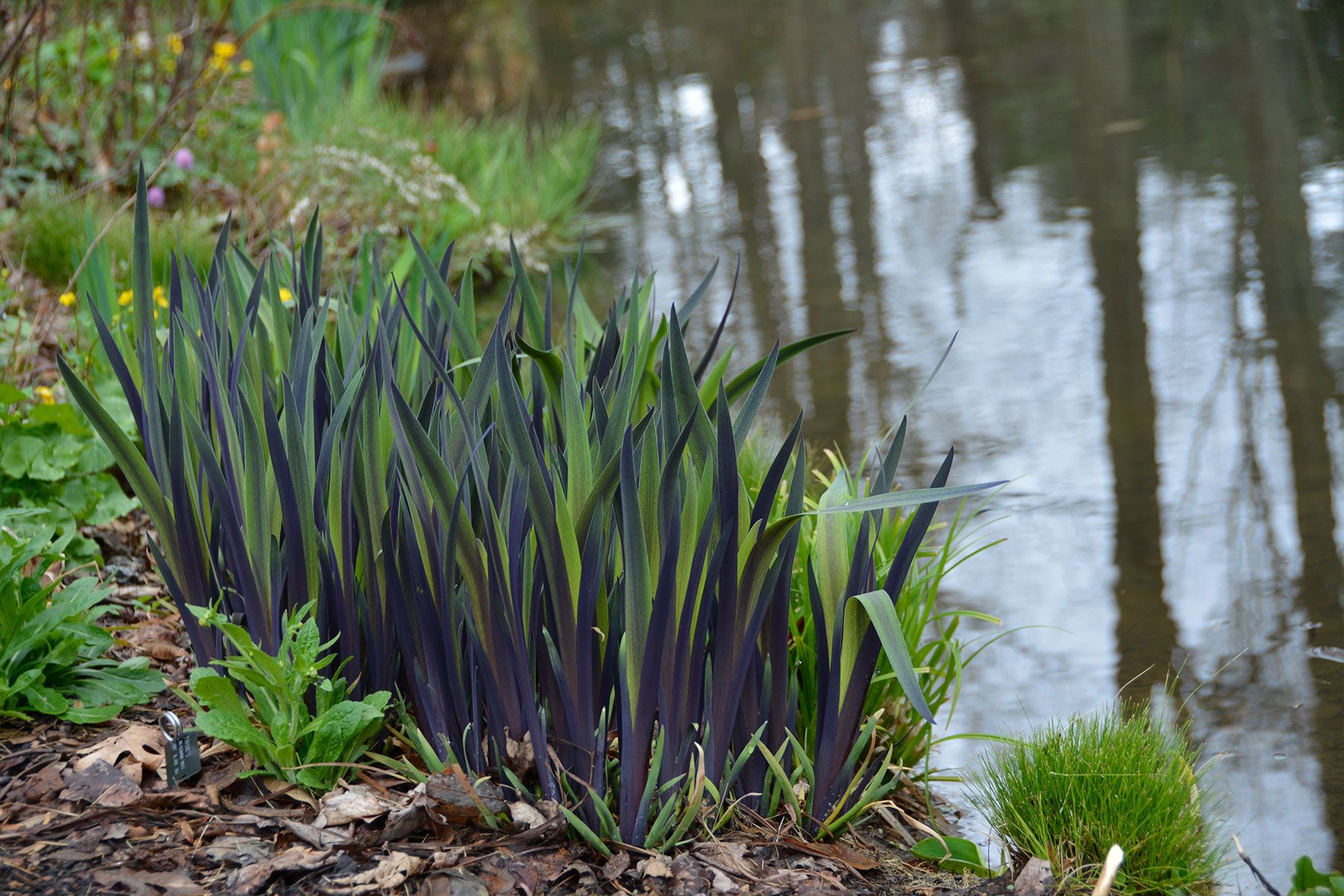
Photo by Mt. Cuba
Eye-Catching Iris
A gardener at Mt. Cuba Center in Hockessin, Delaware, noticed the uncommon eggplant-purple foliage of a native Iris versicolor as it emerged from the ground each spring. Mt. Cuba’s horticulture team propagated the plants and introduced the new selection Iris versicolor ‘Purple Flame’ in 2020. “We have planted it with Caltha palustris, and I just love the combination,” says Susan Boss, a senior horticulturist at Mt. Cuba Center. “The iris’s intense purples go perfectly with the bright-yellow caltha in early spring.”
Source: Izel Native Plants

Photo by Hill Creek Farm
Local Flavor
Pepper pot is a stew that originated in West Africa and the West Indies region of the Caribbean, and in the 19th century, it became a popular street food around Philadelphia thanks to people connected with the culture of those regions. This year, PHS is growing ‘Ole Pepperpot’ pepper (Capsicum annuum var. annuum) for its network of community gardeners, says Emma Ford, PHS City Harvest propagation manager. Local growers preserved the seeds of this heirloom, and now it is available to the public. The pepper is bright red, about 4 to 5 inches long, and moderately spicy. “This a reliable hot pepper that thrives in the area,” Ford says, “and it has deep relevance to black Philadelphians.”
Source: Sistah Seeds
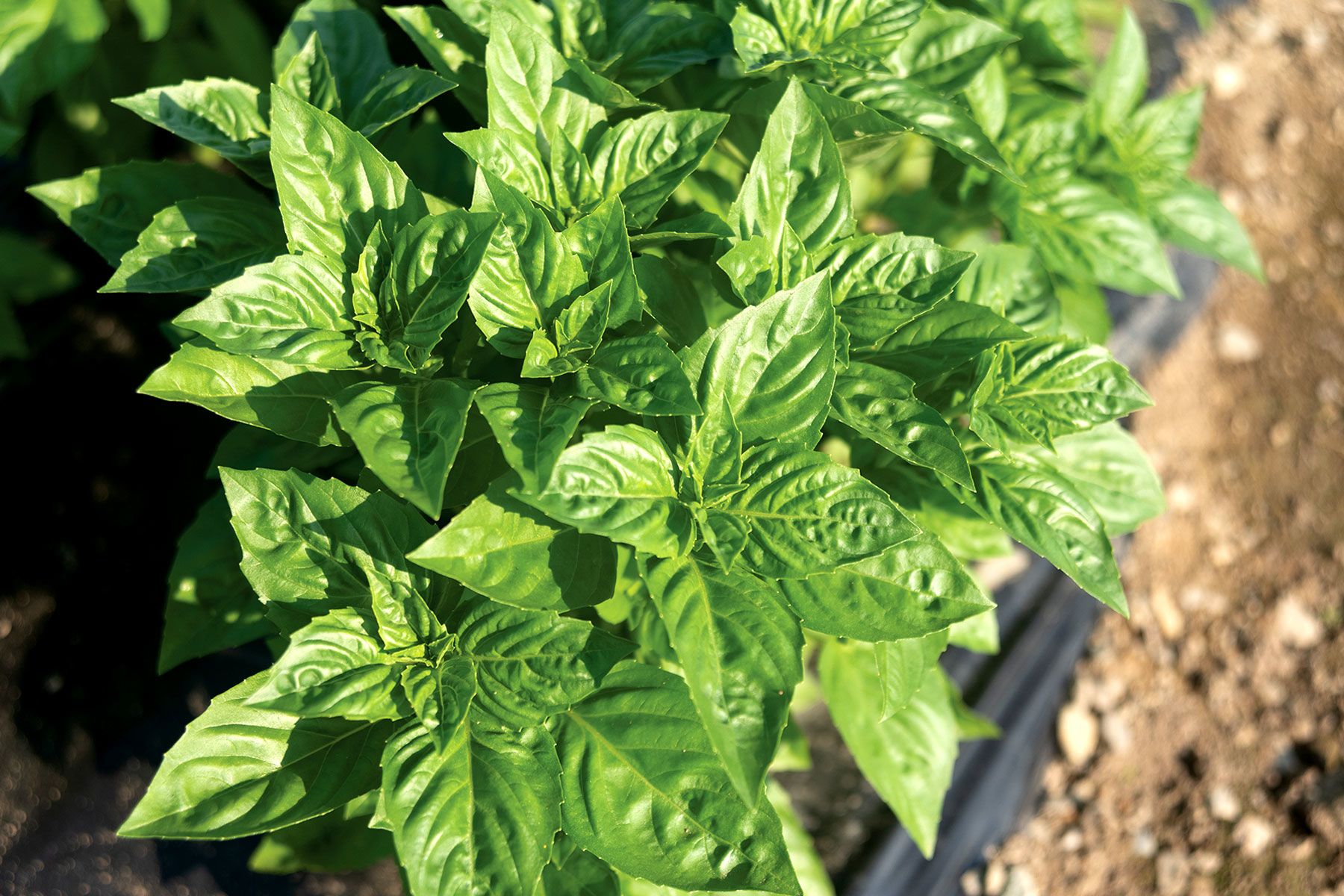
Photo by Johnny’s Selected Seeds
Better Basil
If your basil crop has been spoiled by diseases, try ‘Rutgers Obsession DMR’ (Ocimum basilicum), Ford suggests. It is resistant to downy mildew and fusarium wilt, common problems that affect basil crops. “Ten years of classical plant breeding have delivered reliable results for commercial and home growers,” she says.
Source: Johnny’s Selected Seeds
Bright Little Bulbs
LIGHT UP YOUR LANDSCAPE IN LATE WINTER AND EARLY SPRING WITH CROCUSES, SNOWDROPS, AND OTHER BRILLIANT VARIETIES.
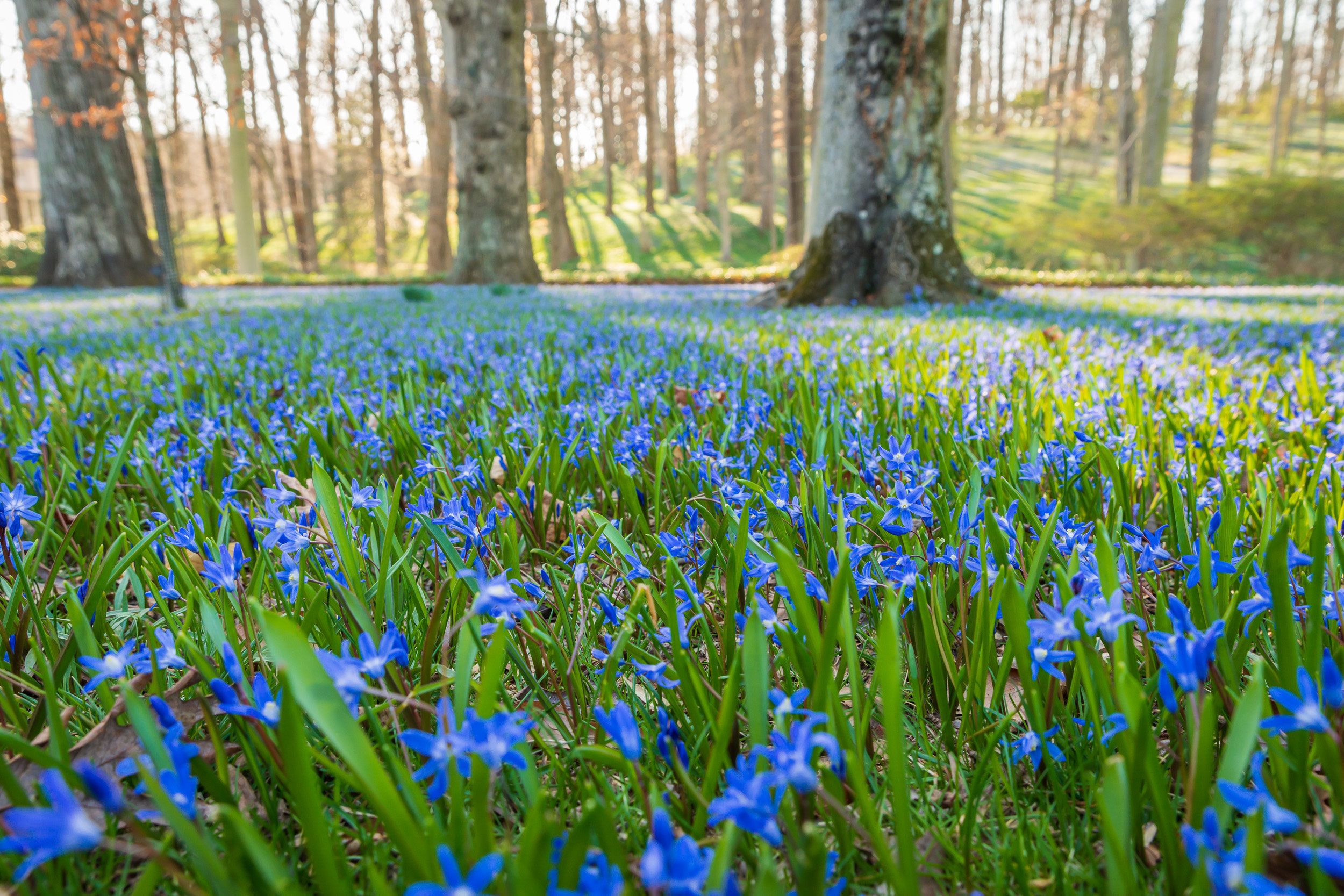
Above: The March Bank at Winterthur, first planted by Henry Francis du Pont more than 100 years ago at his estate in Delaware, is a living, changing carpet of colorful bulbs each spring.

DAFFODILS AND TULIPS ARE A WELCOME SIGHT for eyes that are tired of the grays and browns of the dormant season. But you don’t have to wait for them to bloom to see color return to your garden. You can plant bulbs that come up sooner in vivid purple, buttery yellow, cool white, and electric blue. These varieties, including crocuses, grape hyacinths, scillas, snowdrops, striped squill, and winter aconite, are small in bulb and flower but can be used for a mass effect in the garden and containers.
At Winterthur, the historic public garden in Wilmington, Delaware, a 3-acre slope known as the March Bank becomes an ever-changing showcase of natural beauty as tens of thousands of these bulbs emerge and open their brilliant blossoms week after week in winter and early spring. Carol Long, garden curator at Winterthur, shares her experience with growing them on the job and in her home garden.
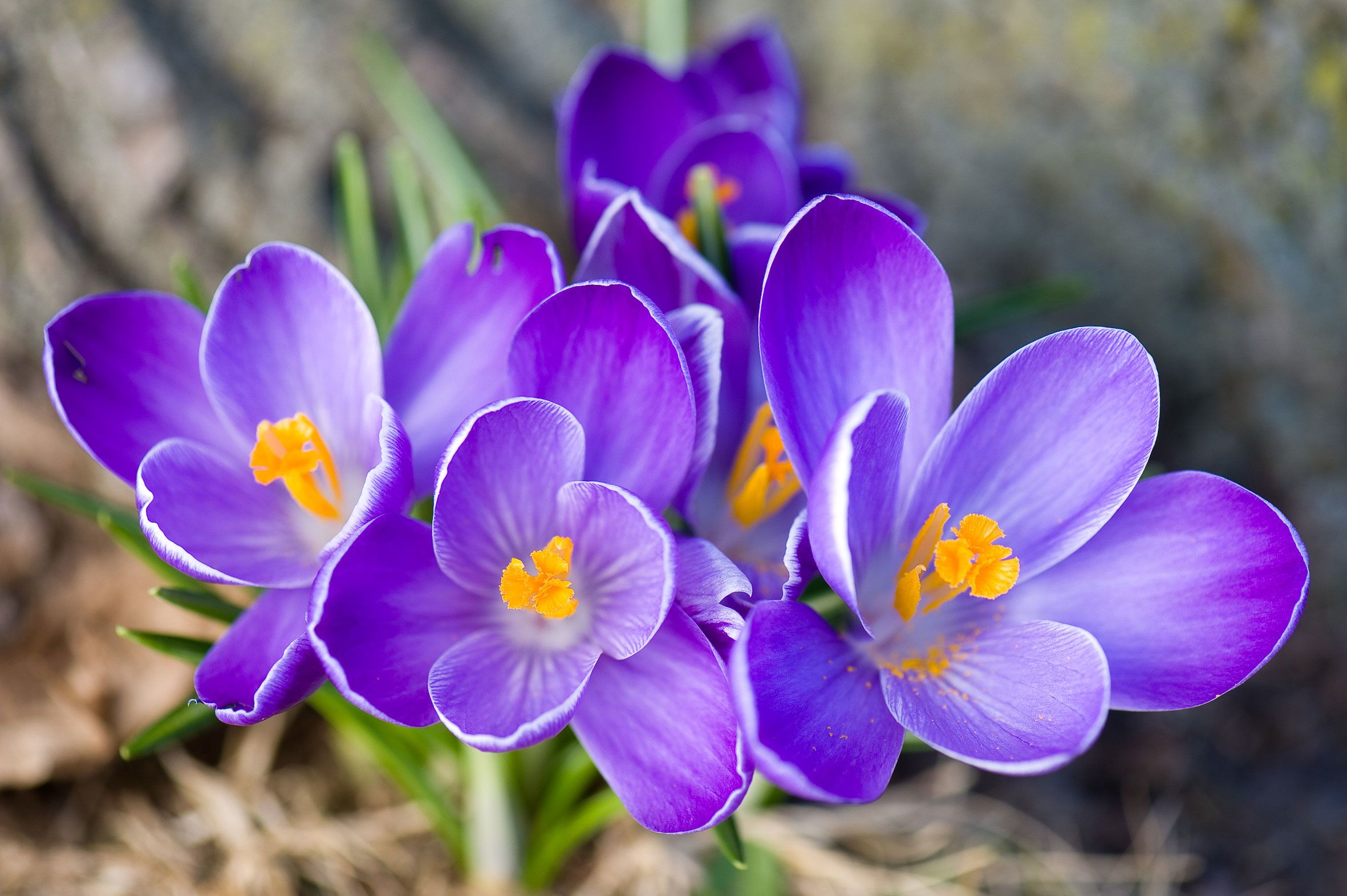
Crocuses and other small bulbs naturalize, or spread on their own, so you get even more blooms as the years pass.
Crocuses and other small bulbs naturalize, or spread on their own, so you get even more blooms as the years pass.
FIRST LIFE
“Winter is a perfect time to observe the changing microclimates in your garden,” Long says. “You will notice the sun’s angle is different from the growing season.” Early-blooming bulbs thrive in those warm, sunlit places. If a part of your landscape is shaded by deciduous trees, you can add color and interest there with bulbs that bloom before the leaves open.
When the earliest bulbs emerge, they are typically the first flowers to open for the season, which makes them an especially important resource for the pollinators that are active at this time, Long says. Since the temperatures are cool, these early flowers tend to last much longer than those opening later in the season, a bonus for both you and the bees, she adds.
Though deer can ravage tulips and other bulbs, the petite species thrive in naturalized displays because they are not a preferred food source for deer. To keep squirrels, voles, and mice from digging up and eating them, spread a layer of gravel on top of the bulbs before covering with soil.
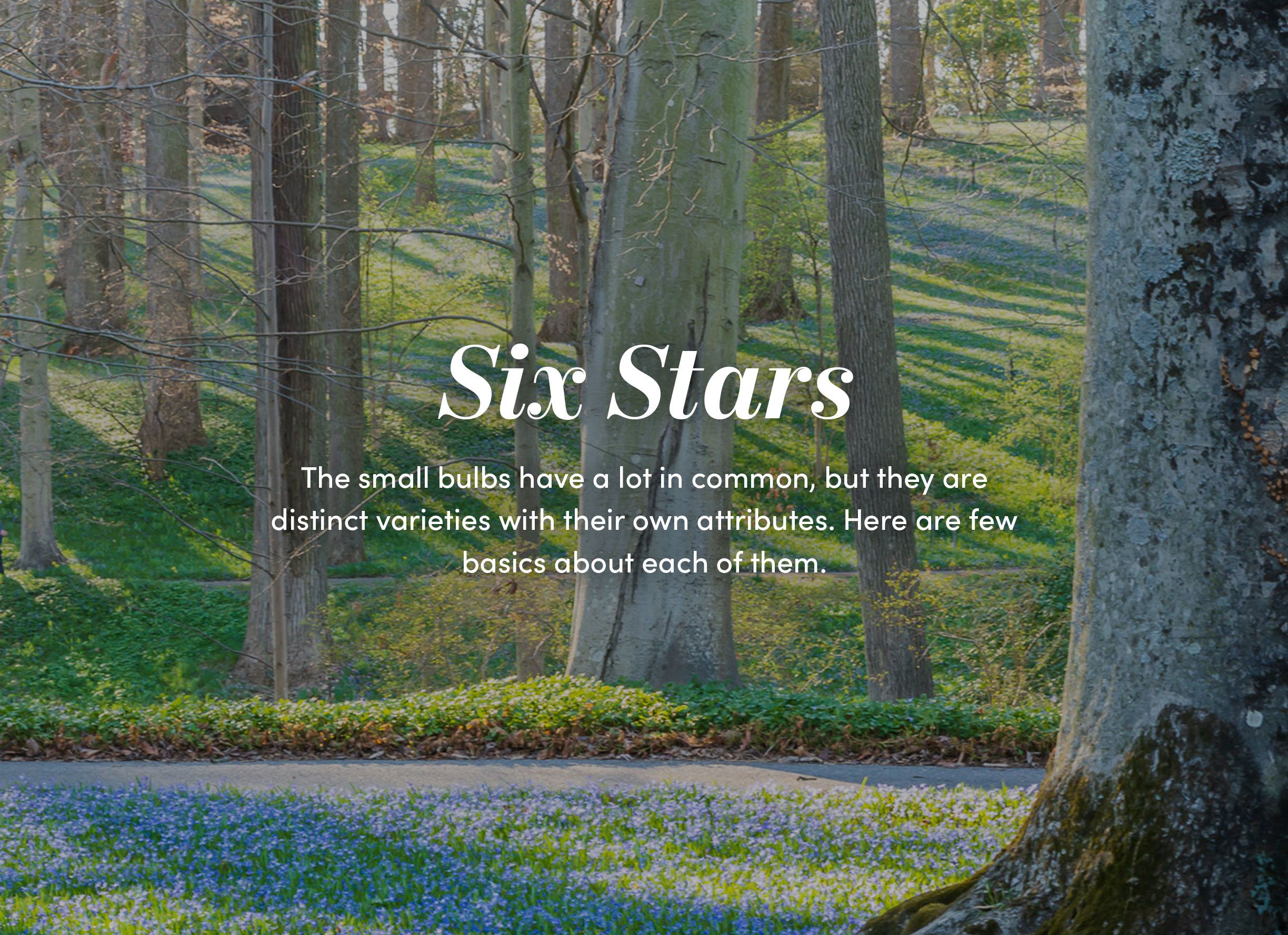
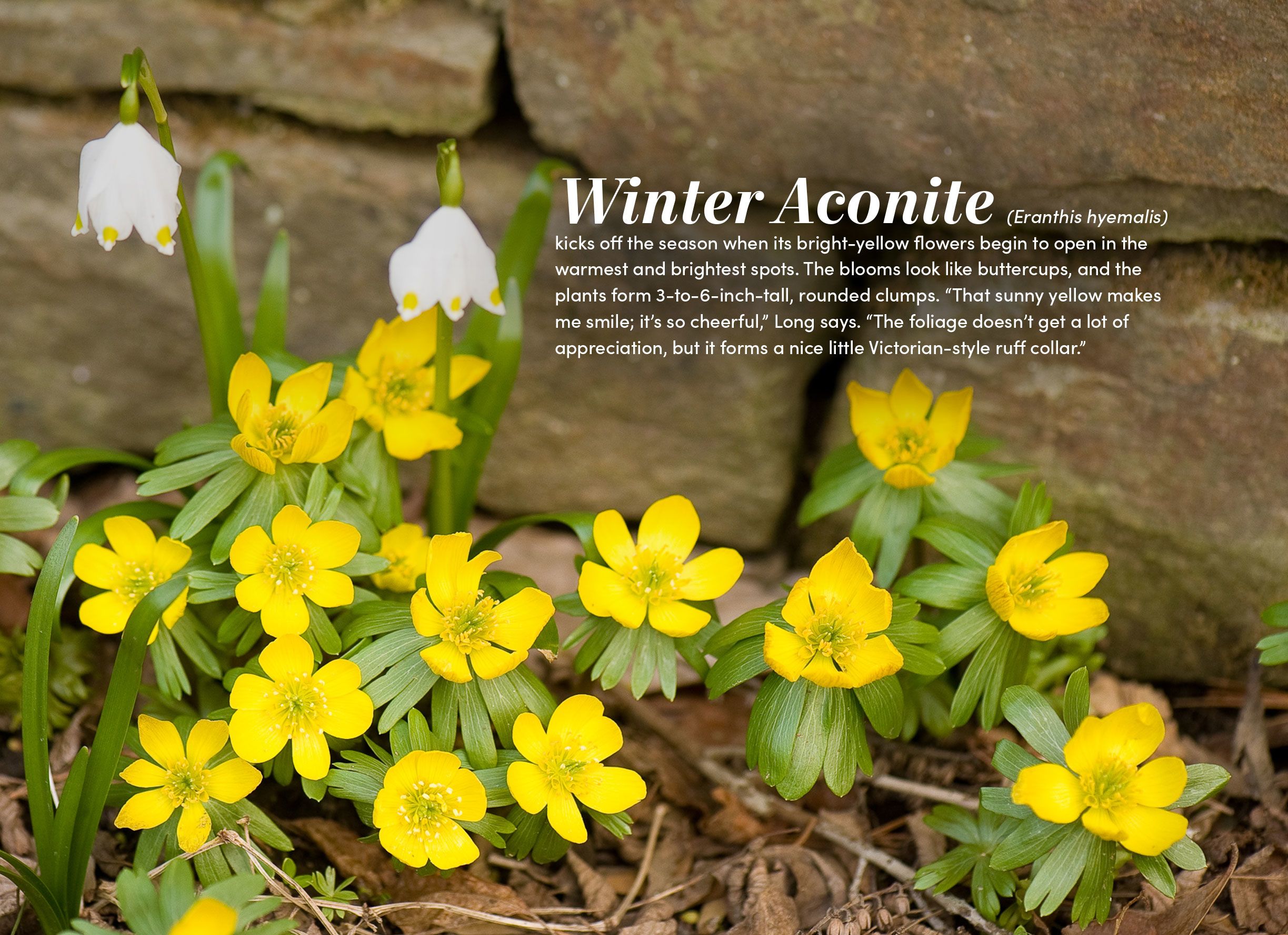
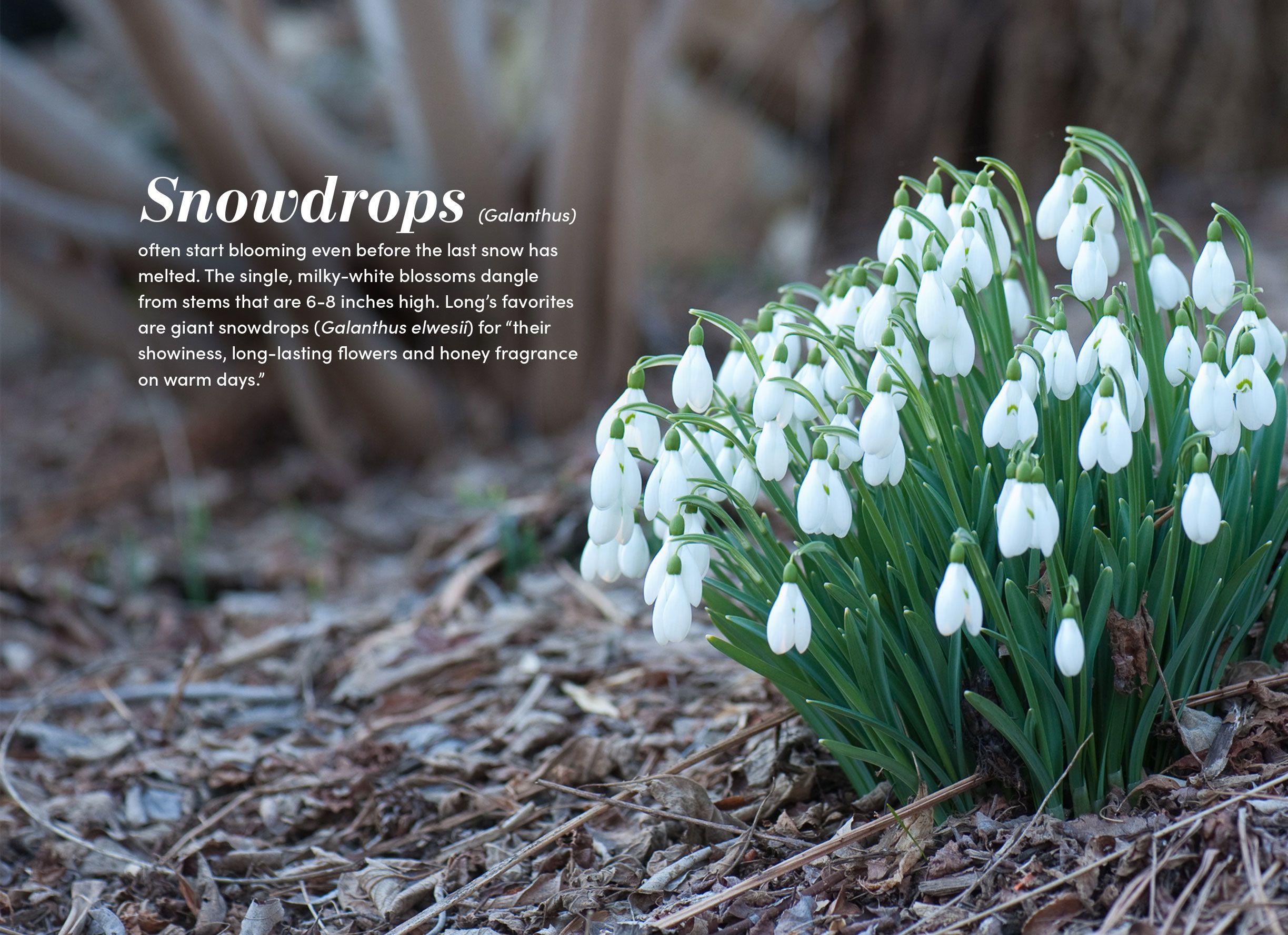
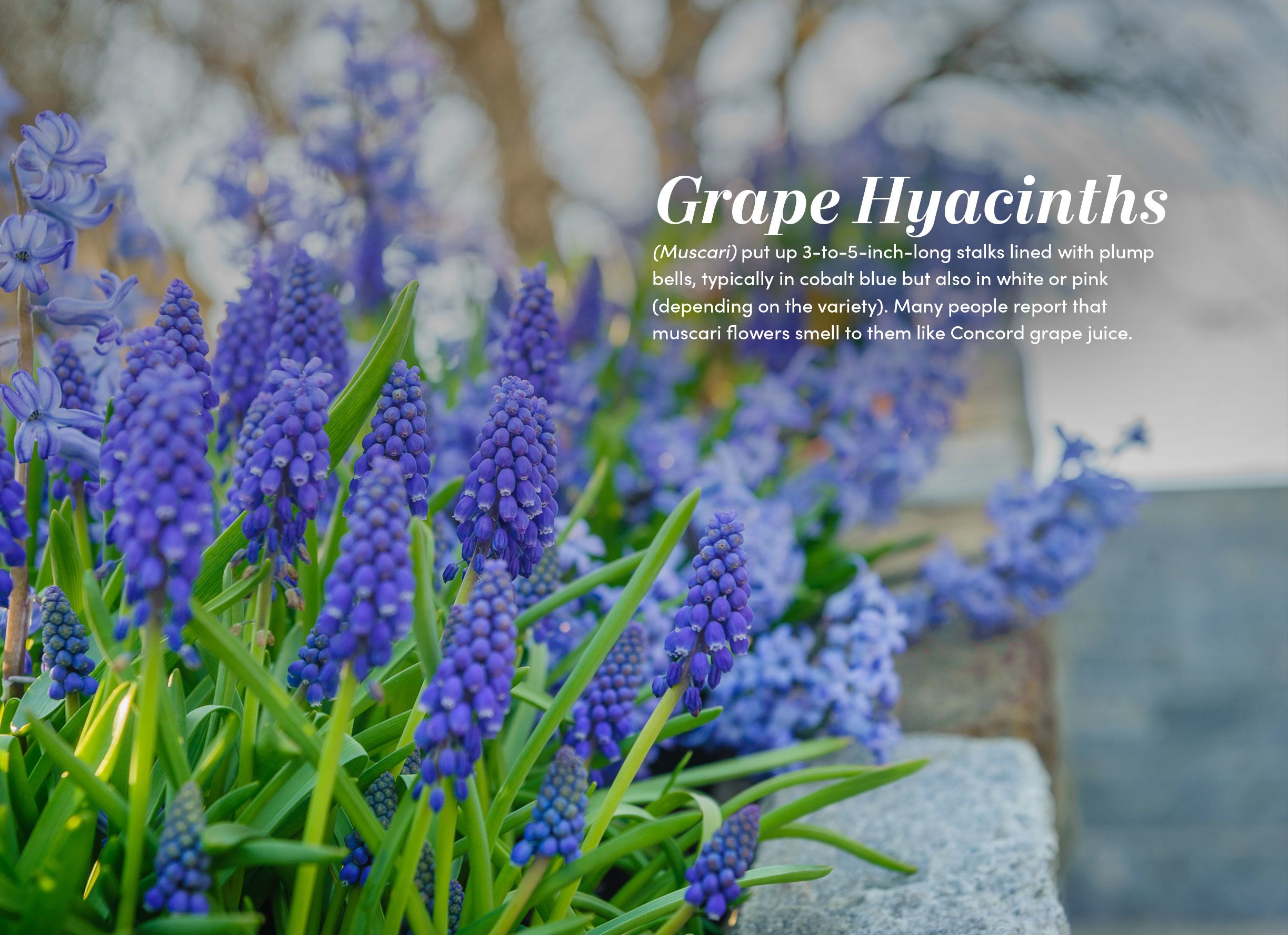
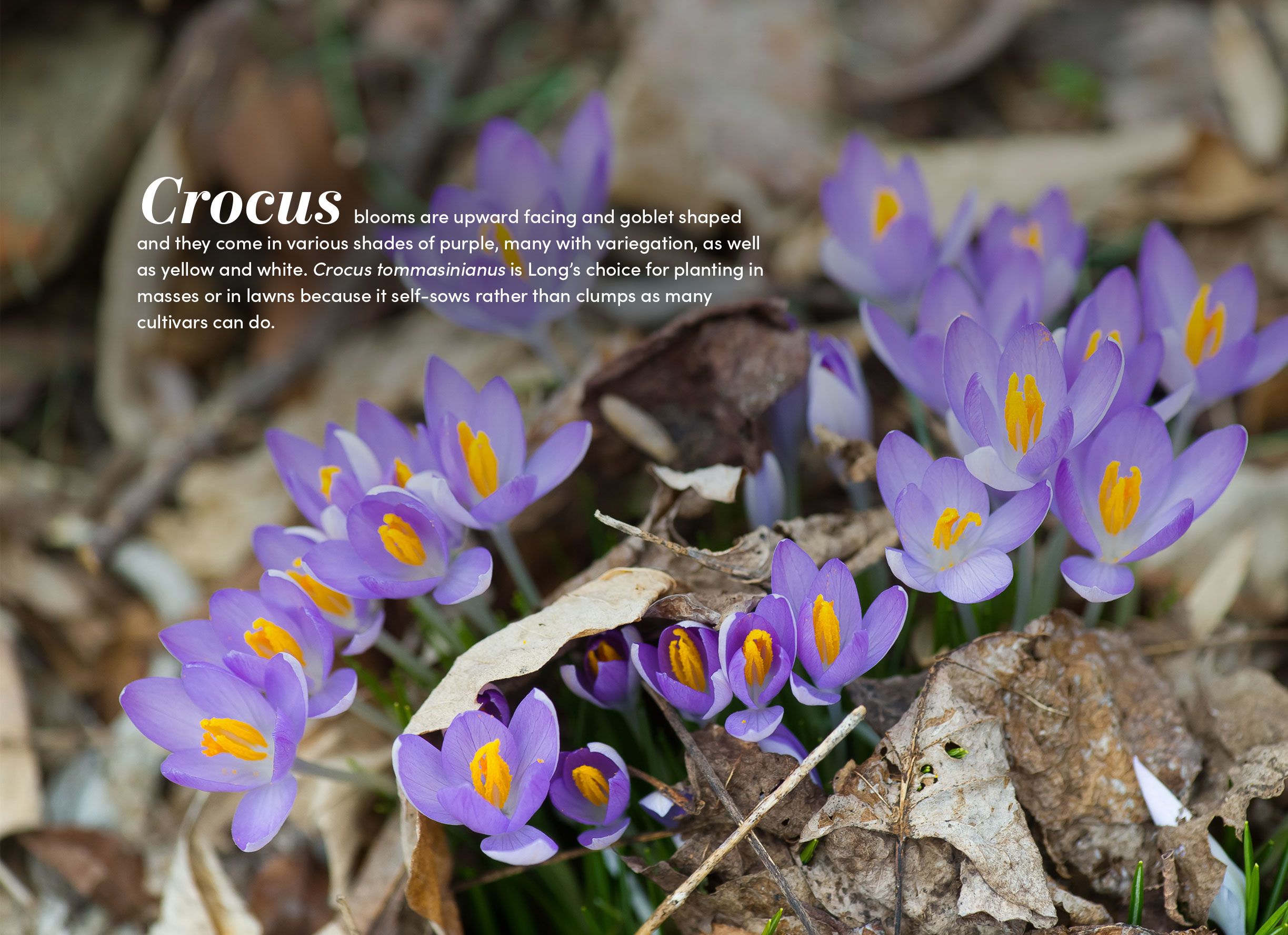
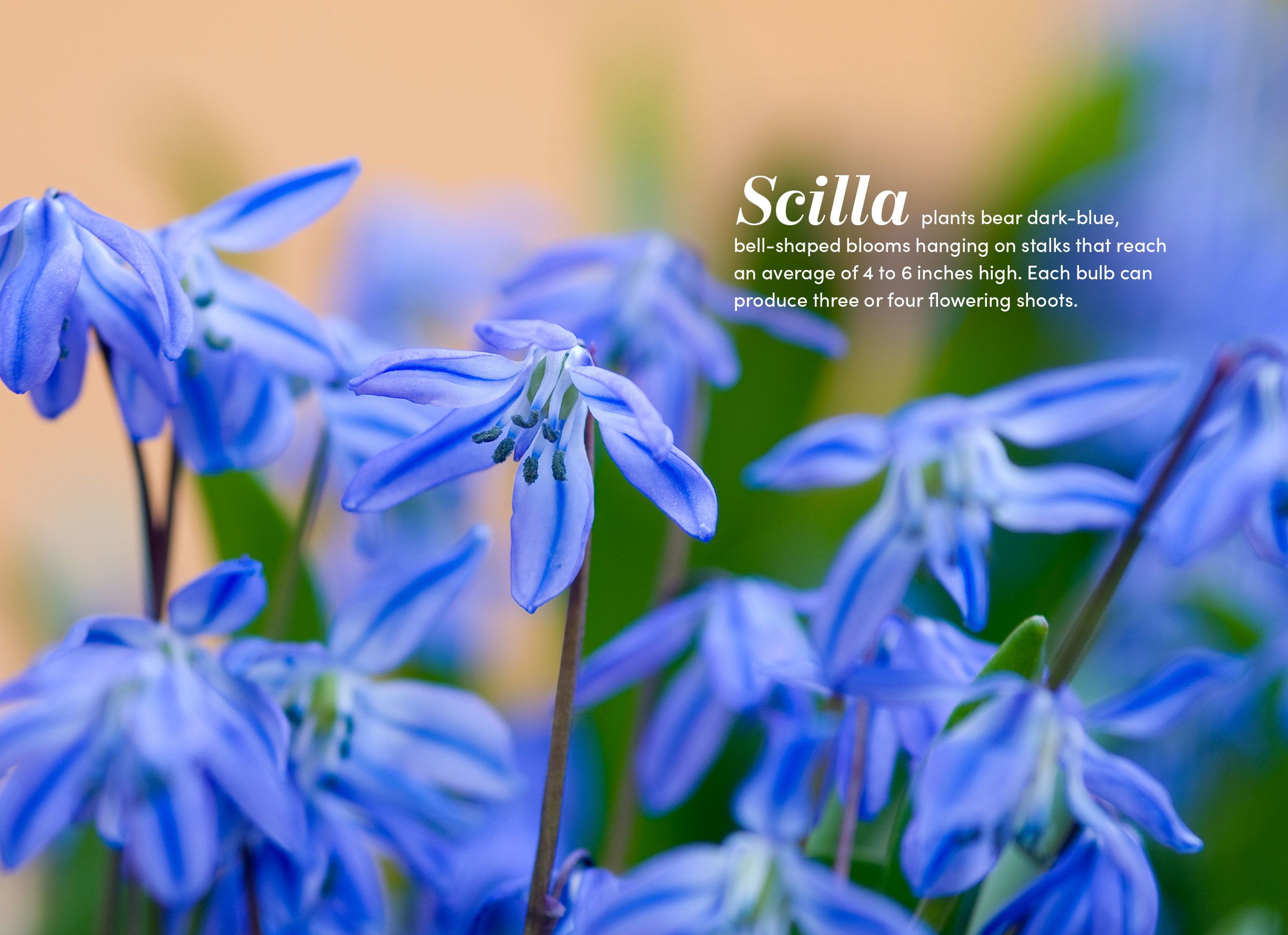
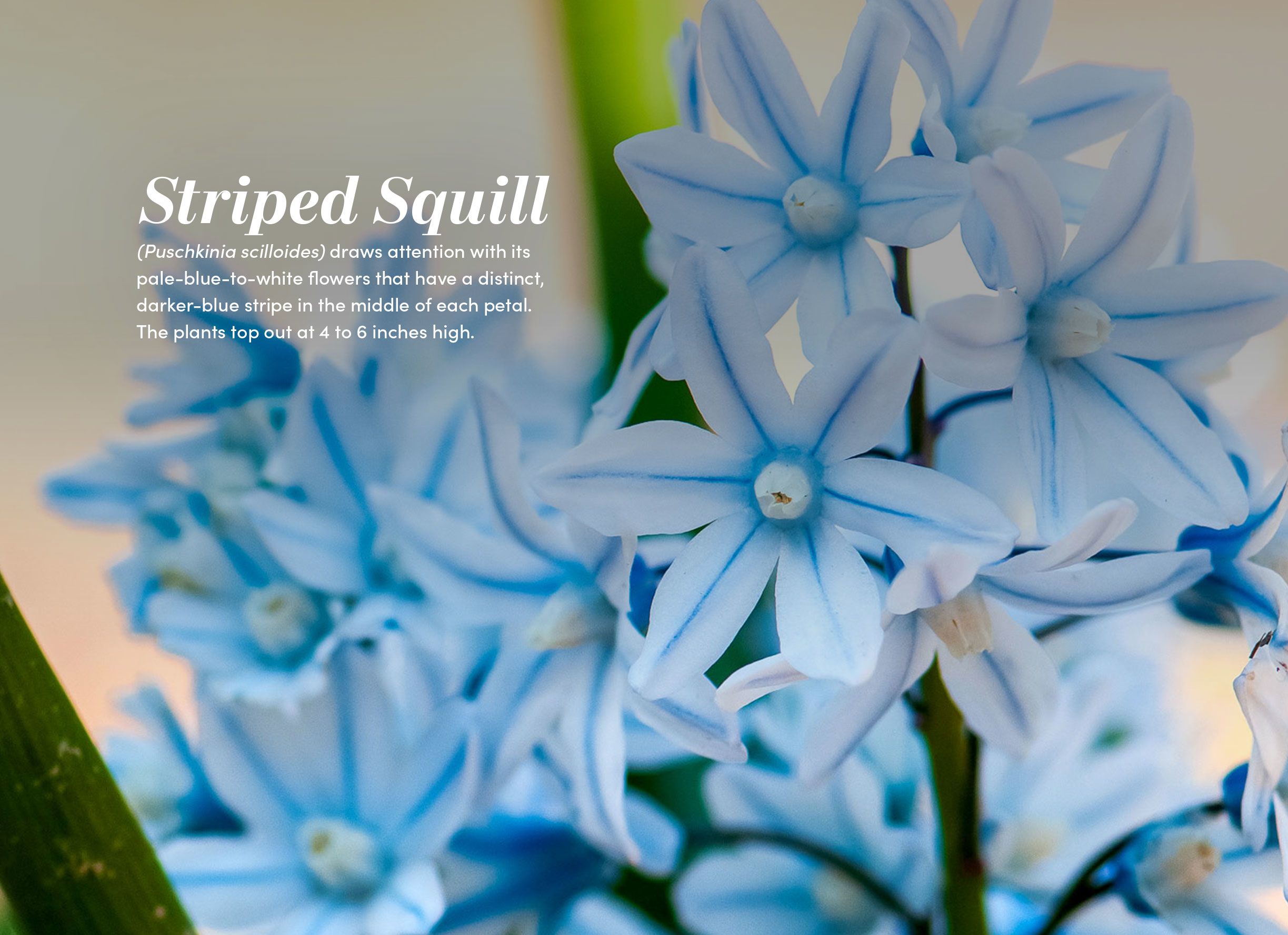
BIG OR SMALL SPACES
All these bulbs are petite, so they tend to have the biggest impact when growing in large groups, Long says. “Big blocks of solid color catch your eyes, so I plant the bulbs in masses” on slopes, in borders, and around tall trees, creating a “carpet of color.”
You can also use the small bulbs to add early-season color and interest to your lawn. They come up while the turfgrass is still dormant in our area, Long notes, so they don’t interfere with your regular mowing. When the bulbs are finished flowering and you’re ready to cut the grass, set the blade at its highest level to allow the foliage to remain until it fades away on its own.
Don’t have space for a mass planting? The small stature of these bulbs makes them ideal for use in large containers. You do have to pay extra attention to keeping them watered through the winter, and you may need to move the pots into a protected area during deep freezes. “Bulbs in pots are not as well insulated as those in the soil are,” Long says.
PLANT AND FORGET
The ideal time to plant these bulbs is on a warm fall day, but you can do it at any time before the ground freezes hard. The bulbs go in about 2 to 6 inches deep depending on the species. If you’re planting thousands, an auger bit on a power drill makes the job easier, Long says. But if you are working in a smaller area, “a sturdy weeding knife is an effective tool for planting lots of these bulbs.”
Newly planted bulbs need moisture, often supplied by fall rains, but they need little care or attention after that. “The most important thing is to allow the foliage to mature completely after flowering,” Long advises. “The sunlight gathered by the foliage is stored as energy for next year’s blooms.”
These small bulb varieties tend to spread naturally in hospitable conditions, creating a mass display on their own. But if you want to encourage them, you can collect and disperse their seeds yourself. “They generally produce viable seeds in April and May,” Long says. “Collect the seeds when they turn yellow and sprinkle them where you want them to grow.” In short order, you’ll have a big display of little bulbs.
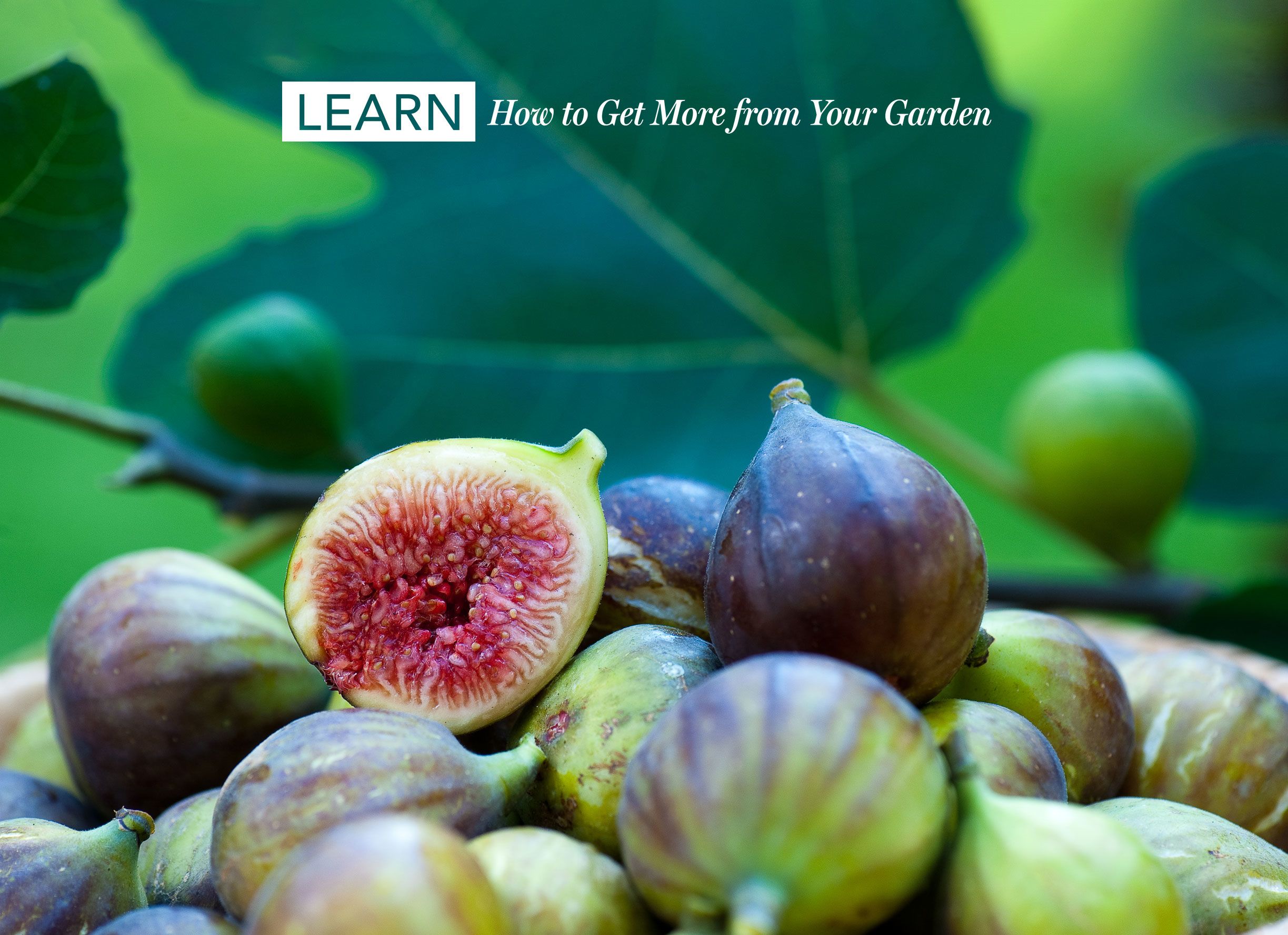
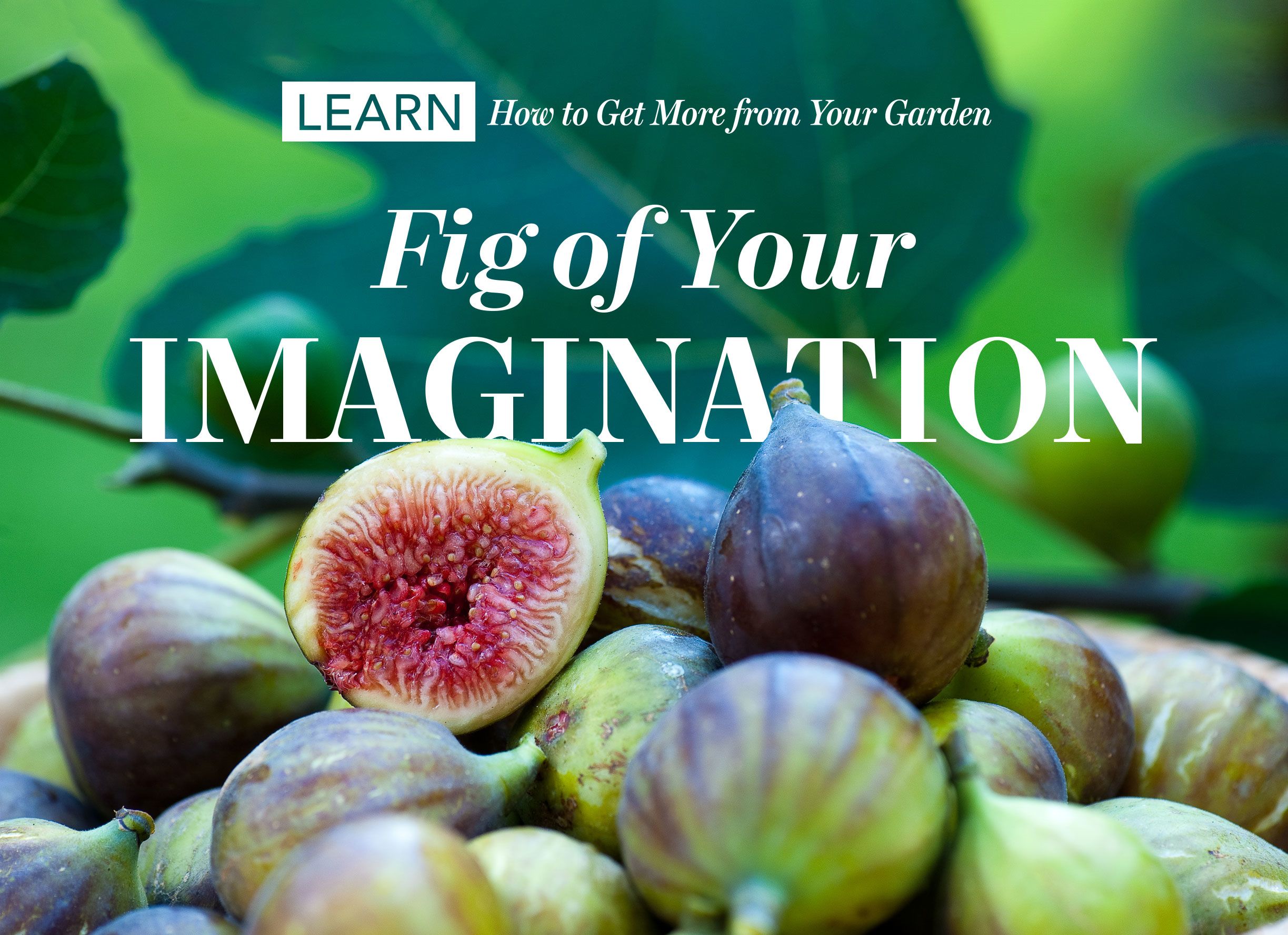
YOU CAN GROW YOUR OWN FRESH FRUIT IN ANY SPACE
DOES HARVESTING HOMEGROWN, READY-TO-EAT FRUIT from your own trees sound enticing but intimidating? Figs are your solution. If you’ve never tried a fresh-picked fig, it is sweeter and juicier than the dried paste inside Fig Newton cookies. Fresh figs taste like honey-sweetened berries, and people of all ages love them because they have no pits or peels to remove. Best of all, figs are among the easiest types of tree fruit to grow in our climate, says Phil Forsyth, co–executive director of the Philadelphia Orchard Project. Forsyth has been planting fig trees around the region for 16 years, and we asked for his advice on growing them in your garden.
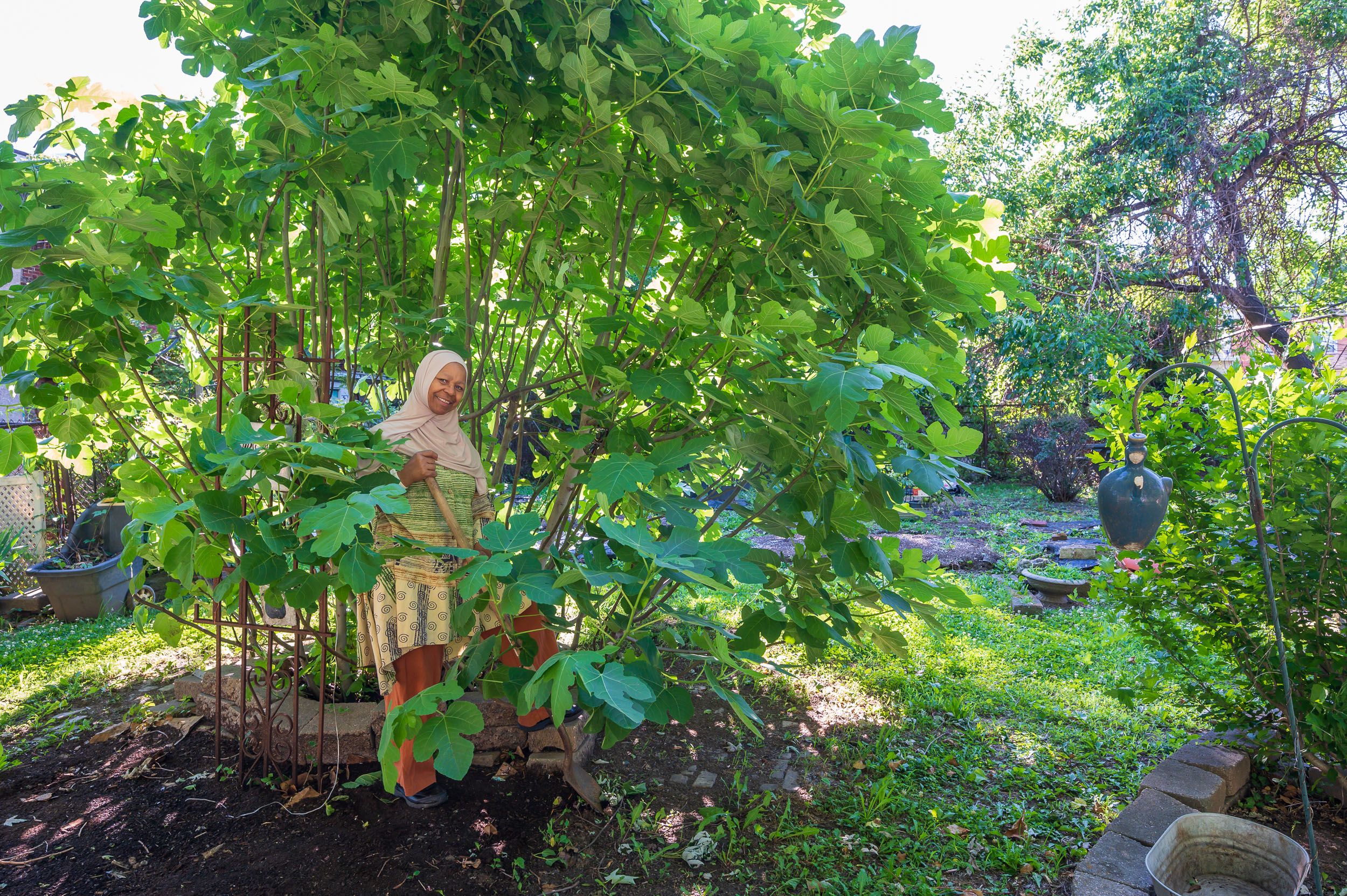
Fig trees are adaptable to a wide range of conditions and can do well in urban settings, like this one tended by Safiyah Latif in Nicetown’s Jannatain Garden.
Fig trees are adaptable to a wide range of conditions and can do well in urban settings, like this one tended by Safiyah Latif in Nicetown’s Jannatain Garden.
PRIME CONDITIONS
Fig trees thrive even in poor soil and adapt well to the conditions in cities or suburbs, Forsyth says. Their only requirement is a spot that gets six to eight hours of direct summer sunlight. Fig trees typically survive winter in our region, but the coldest temperatures can damage them. Planting a fig tree near a south-facing wall provides it with lots of bright light during the growing season and shields it from bitter winter cold and winds. You can also grow a fig tree in a large container and move it around to maximize the sunlight during the growing season and protect the plant in winter.
YOUR CHOICES
Many nurseries in our region sell young fig trees in spring. They also are often available at the Philadelphia Orchard Project’s annual plant sale. If you know a gardener with a tree that bears tasty figs, ask for a cutting and get it to form roots by planting it directly in the garden or in a pot with soil mix or placing it in a bucket of water. When you have a choice of varieties, look for ‘Chicago Hardy’, ‘Celeste’, and ‘Brooklyn White’, all of which are winter hardy here, Forsyth says. Mature fig trees typically reach from 10 to 30 feet tall, depending on conditions and the variety. ‘Fignomenal’ is a new miniature variety that grows only 2 to 3 feet tall, so it is ideal for small gardens and large containers.
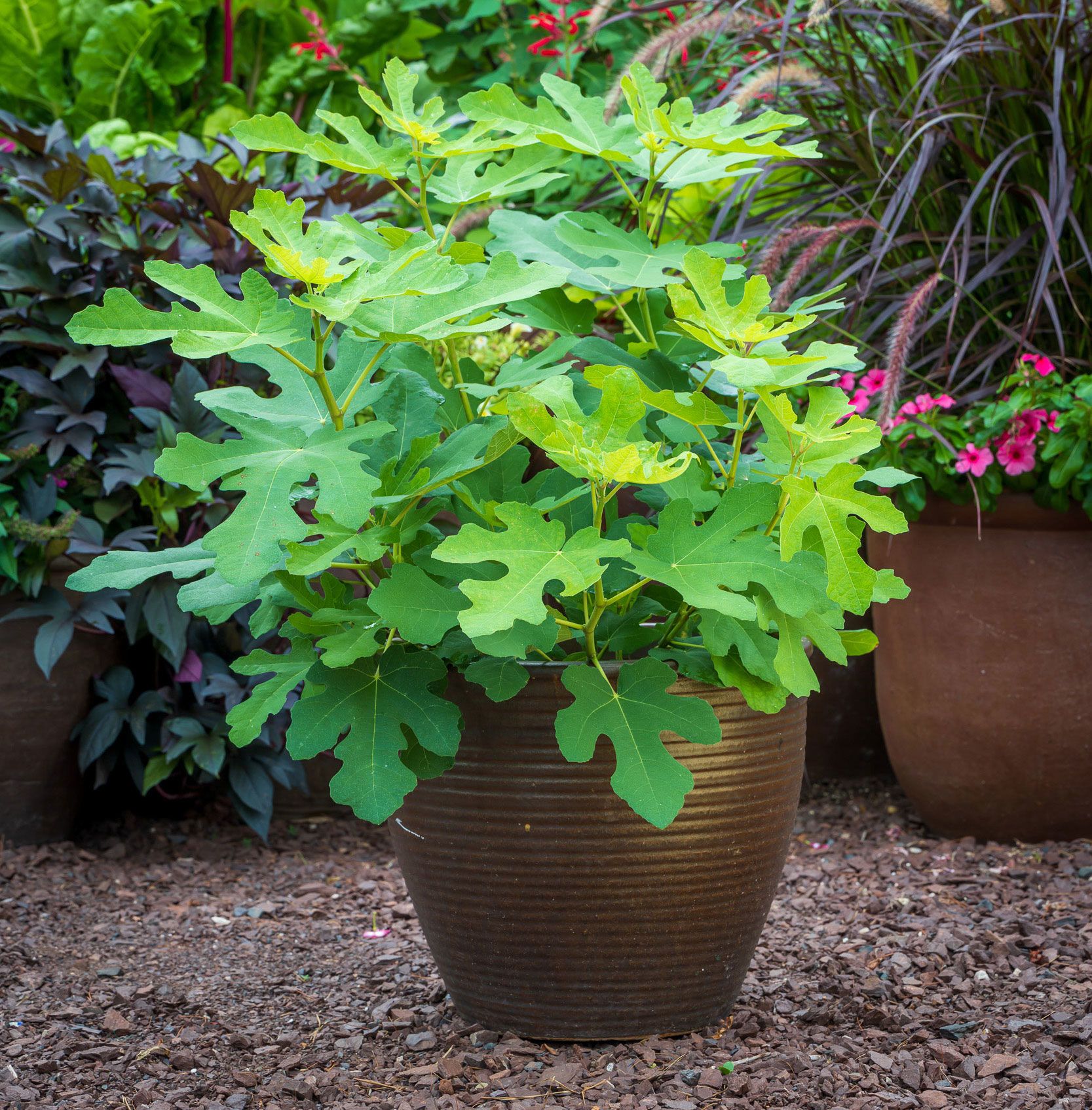
Recently introduced 'Fignomenal' stays compact, so it's a smart choice for containers and small spaces.
Recently introduced 'Fignomenal' stays compact, so it's a smart choice for containers and small spaces.
Unlike many other types of fruit, figs don’t require pollination, so just one tree will produce a crop for you. Once they begin to ripen their first fruit in August or September, many fig varieties will produce fruit continuously through the end of October.
EASY CARE
Spring is the best time to plant a fig tree, so it can establish a root system before winter. You will need to water a newly planted tree weekly for the first year, but because figs are suited to dry Mediterranean climates, “you may never have to water again,” Forsyth says. One reason figs are so popular with gardeners is that the fruit has no widespread disease or pest problems, except for hungry squirrels. Extended periods of temperatures below 20°F can cause the aboveground growth of fig trees to die back, but the roots typically resprout in the spring. Some growers give their fig trees extra protection from extreme cold by wrapping them in late fall with wire fencing stuffed with leaves, thick blankets, burlap, tarps, or other insulating materials.
PRUNING FOR GROWTH
Fig trees don’t need to be pruned, Forsyth says, but pruning will encourage more fruit production. And since the trees can reach up to 30 feet high, pruning off the top growth will make the ripe fruits easier for you to pick. Botanically speaking, fig plants are actually shrubs (not trees), so they adapt well to shaping and training to fit your space.
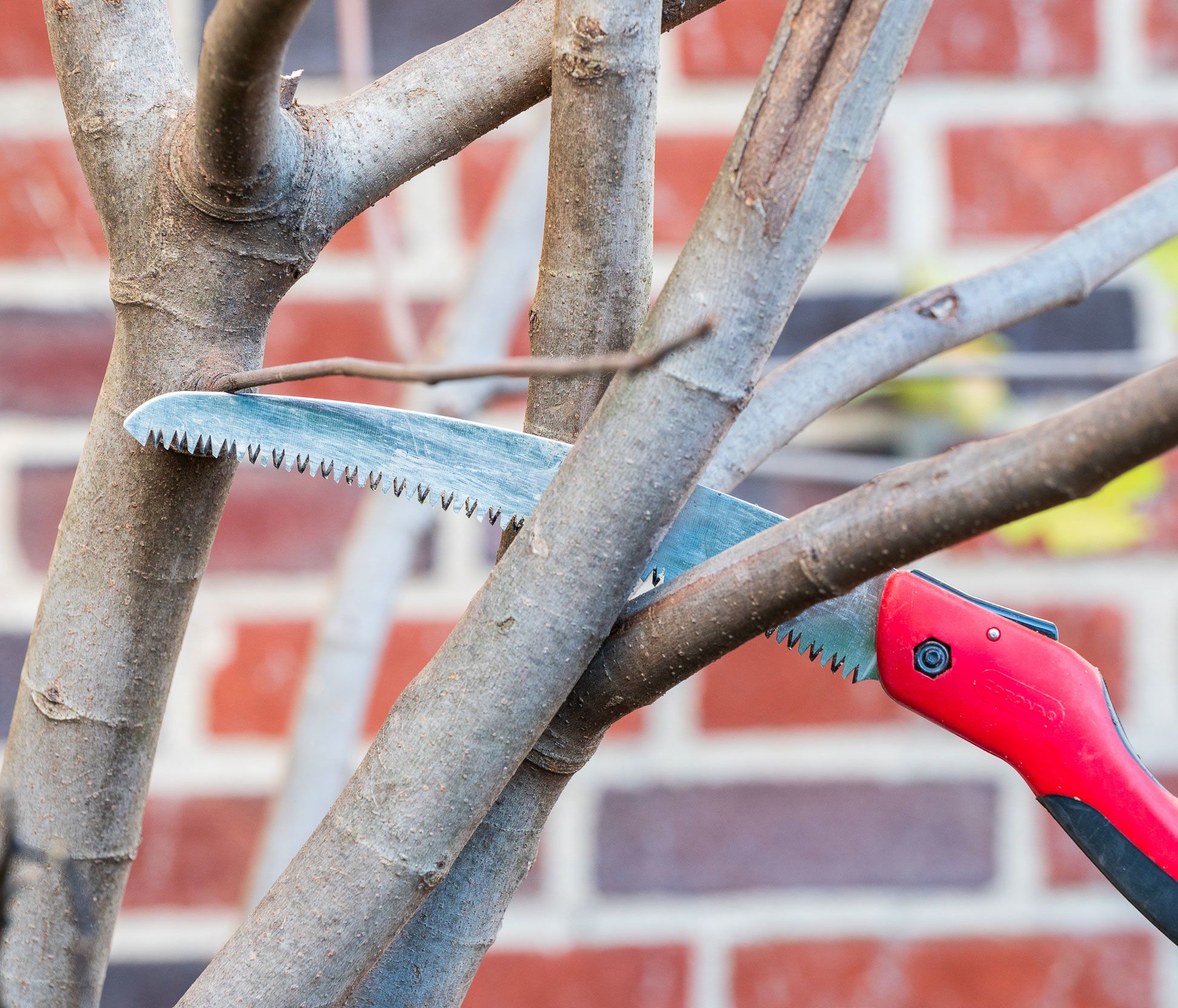
Pruning figs in winter lets you shape their growth and can increase their yield.
Pruning figs in winter lets you shape their growth and can increase their yield.
The optimal time to prune figs is in winter, while the trees are dormant. The trees produce their annual crop on new growth, so you can trim and shape them in winter without sacrificing your next harvest. For a healthy, long-lived plant, first focus your pruning on establishing a strong central leader (trunk) and a few sturdy main branches growing away from it. To keep the tree robust and shapely as it grows, each year trim back main branches by about one-third and eliminate smaller branches too weak to bear the weight of fruit. Also, be sure to remove dead or diseased growth and branches that extend toward the core of the tree rather than away from it. This will allow sunlight and airflow into the center of the plant.
HARVEST READY
With some fruit trees, you must wait for years before the first crop, but figs start bearing a crop in their second season. In our region, the fruit generally ripens in late summer to early fall (depending on the variety). The process from fruit formation to full ripeness can take up to two months.
When fig fruits are ready to pick, they tend to droop from the branches and are a bit squishy to the touch. Forsyth harvests them when they first start feeling soft to prevent squirrels from eating them as they ripen. The figs will finish softening and turning sweet in a few days at room temperature, but you can slow the ripening process by storing them in your fridge.
Eleven years ago, Forsyth took home a cutting from a fig tree he found in a front yard in West Philadelphia. He nicknamed it ‘Larchwood’ for the street where he collected it. In 2022, the now 20-by-20-foot tree yielded more than 40 pounds of fruit, which he shared with lucky friends and family. When the fig tidal wave is upon him, Forsyth will freeze the fruits whole in plastic bags and make jam with them at a later date. You can also preserve your homegrown fruits by drying them in a food dehydrator or a low-temperature oven. But the best way to enjoy a luscious fig is to bite into one when you pluck it from the tree.
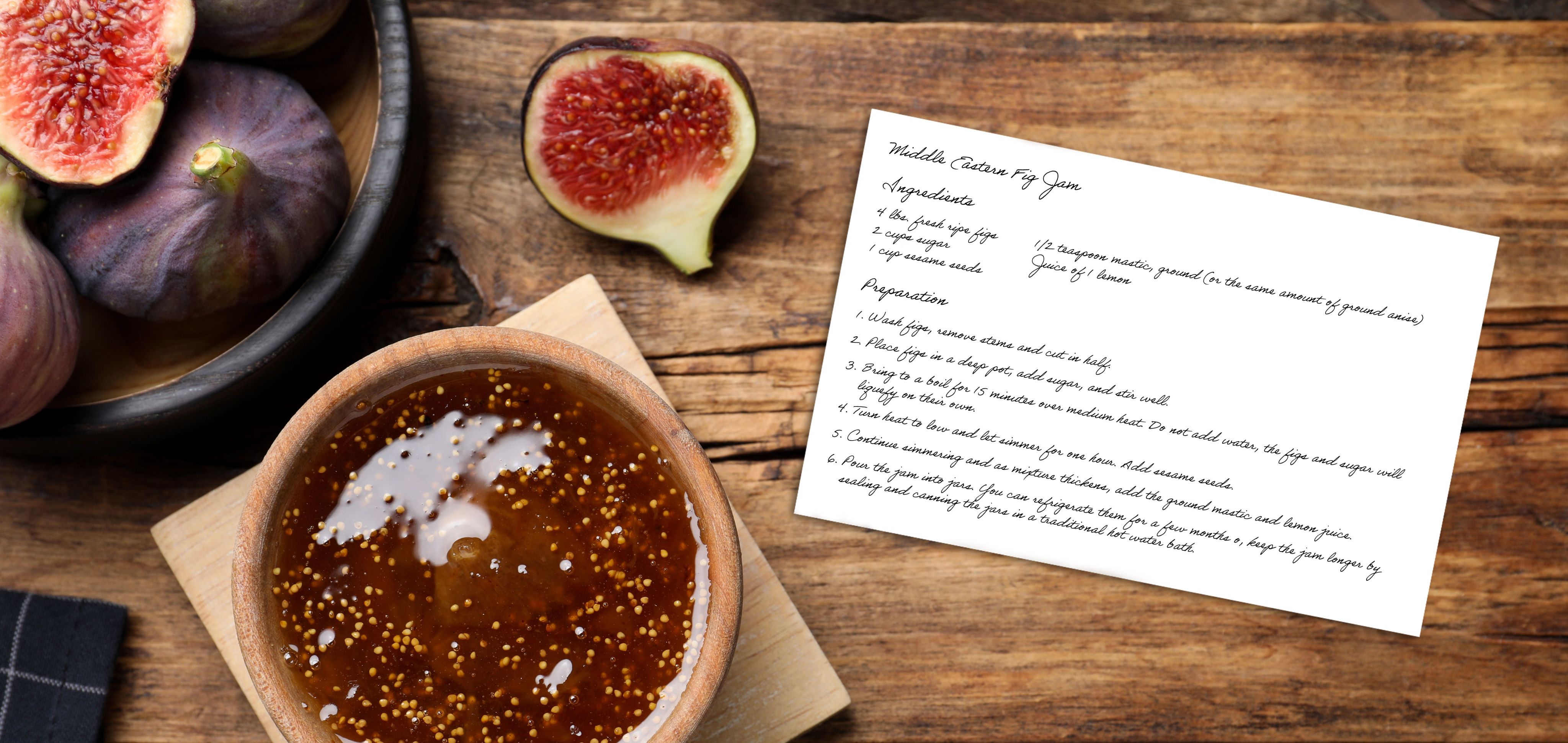
Photo by New Africa/Shutterstock
Middle Eastern Fig Jam
There are lots of recipes for fig jam in cookbooks and online, but this one has a regional flair. The recipe, from Bass Samaan, the owner of Trees of Joy, a fruit tree nursery in Bethlehem, Pennsylvania, features an unusual ingredient: mastic. It’s a resinous gum from a Middle Eastern tree with a subtle piney flavor that complements the sweetness of the figs. Mastic, found in ethnic grocery stores, typically comes as small “pebbles” that are ground to a powder using a mortar and pestle (or two big spoons). This recipe makes about eight half-pint jars of jam.
INGREDIENTS
4 lbs. fresh ripe figs
2 cups sugar
1 cup sesame seeds
1/2 teaspoon mastic, ground (or the same amount of ground anise)
Juice of 1 lemon
PREPARATION
1. Wash figs, remove stems and cut in half.
2. Place figs in a deep pot, add sugar, and stir well.
3. Bring to a boil for 15 minutes over medium heat. Do not add water, the figs and sugar will liquefy on their own.
4. Turn heat to low and let simmer for one hour. Add sesame seeds.
5. Continue simmering and as mixture thickens, add the ground mastic and lemon juice.
6. Pour the jam into jars. You can refrigerate them for a few months or keep the jam longer by sealing and canning the jars in a traditional hot water bath.

Veteran Volunteer
A LIFELONG GARDENER ENJOYS SHARING HIS WISDOM FAR AND WIDE.
Edwin MacFarland likes to say that he’s “always had his hands in the dirt.” The retired funeral director chuckles at his joke, but he’s also serious about the time he spends with plants and gardens. In addition to tending the beds and containers around his home in Glenside, Pennsylvania, he is an active member of several plant societies and a regular volunteer at the PHS Philadelphia Flower Show, Meadowbrook Farm, and Pop Up Gardens. For his many years of helping others share in the benefits of gardening, MacFarland was presented in November 2023 with the PHS Medal of Achievement.
“I find gardening therapeutic. It’s calming,” the 74-year-old says.
“The work of a funeral director can be stressful. Sometimes you just want to cry with the people who come to you. My garden was always the best place for me to let go of all that.”
FAMILY MATTERS
MacFarland first found joy in the garden as a boy growing up in the Torresdale section of Philadelphia. His father had an extensive backyard vegetable garden. MacFarland’s maternal grandparents, immigrants from Germany and Switzerland, lived next door, and he has fond memories of the berries, asparagus, and apples they grew. His paternal grandfather also lived nearby and raised onions, peas, and carrots, MacFarland recalls.
One summer while MacFarland was in high school, he spent time working on his uncle’s farm in Switzerland, and he later served two tours of duty during the war in Vietnam. Those experiences shaped his life. “You see a lot and learn a lot when you go away from your home,” he says. He went to college and studied marine biology but ultimately put his science background to use in a career managing a funeral home.
MacFarland had regularly attended the Philadelphia Flower Show as a child, and he continued as an adult. “In 1980, when the show was still in the old Philadelphia Civic Center, I found out that if I volunteered to help, I could get a free ticket,” MacFarland says. “Sign me up!”
His first assignment was in the show’s merchandise shop, but soon his knowledge of plants landed him in the PHS horticulture information booth. “In those days, we had a table, a few pencils, paper, and one reference book,” he recalls. He has worked in the booth at nearly every Flower Show since. “It’s very rewarding. Many people come to you feeling frustrated. They have a plant that’s not doing well, and they need advice on caring for it. I get a lot of satisfaction out of helping people.”
SOCIAL CONNECTIONS
MacFarland’s home garden includes both edible and ornamental plants. “A friend from church gave me garlic bulbs that I have planted,” he says. “I have four fig trees growing in pots. In late fall, I lay them over and cover them with oak leaves, which hold their loft better than other kinds of leaves. I learned that from my grandmother.” He has several varieties of roses, which are favorites of his wife, Linda, who cuts and brings them into the house. In his small greenhouse, he raises begonias, and the couple care for a mix of African violets growing on an extended windowsill in their kitchen.
As MacFarland grew older and gained free time, he joined the Tamanend Park Herb Gardening Club (based in Southampton, Pennsylvania). He is now the club’s president. “We have plant sales and plant swaps every year. That’s another chance to help people to be successful in their gardens,” he says. “This year we sponsored two scholarships to Delaware Valley University,” which offers degrees in horticulture, landscape design, and environmental science.
MacFarland is also a member of the Delaware Valley chapter of the American Begonia Society, and he’s become a judge for regional hosta organizations. “I really love plant competitions,” he says.
The next Flower Show will be March 2 to 10, 2024, and you can be sure MacFarland will be there. The theme, United by Flowers, echoes his feelings. “The family of volunteers is big and full of friendly people,” he says. “It’s like a reunion when we see each other at the show.”
To get in on the fun and satisfaction of being a volunteer at the Flower Show and other PHS activities, go to the PHS volunteer hub.
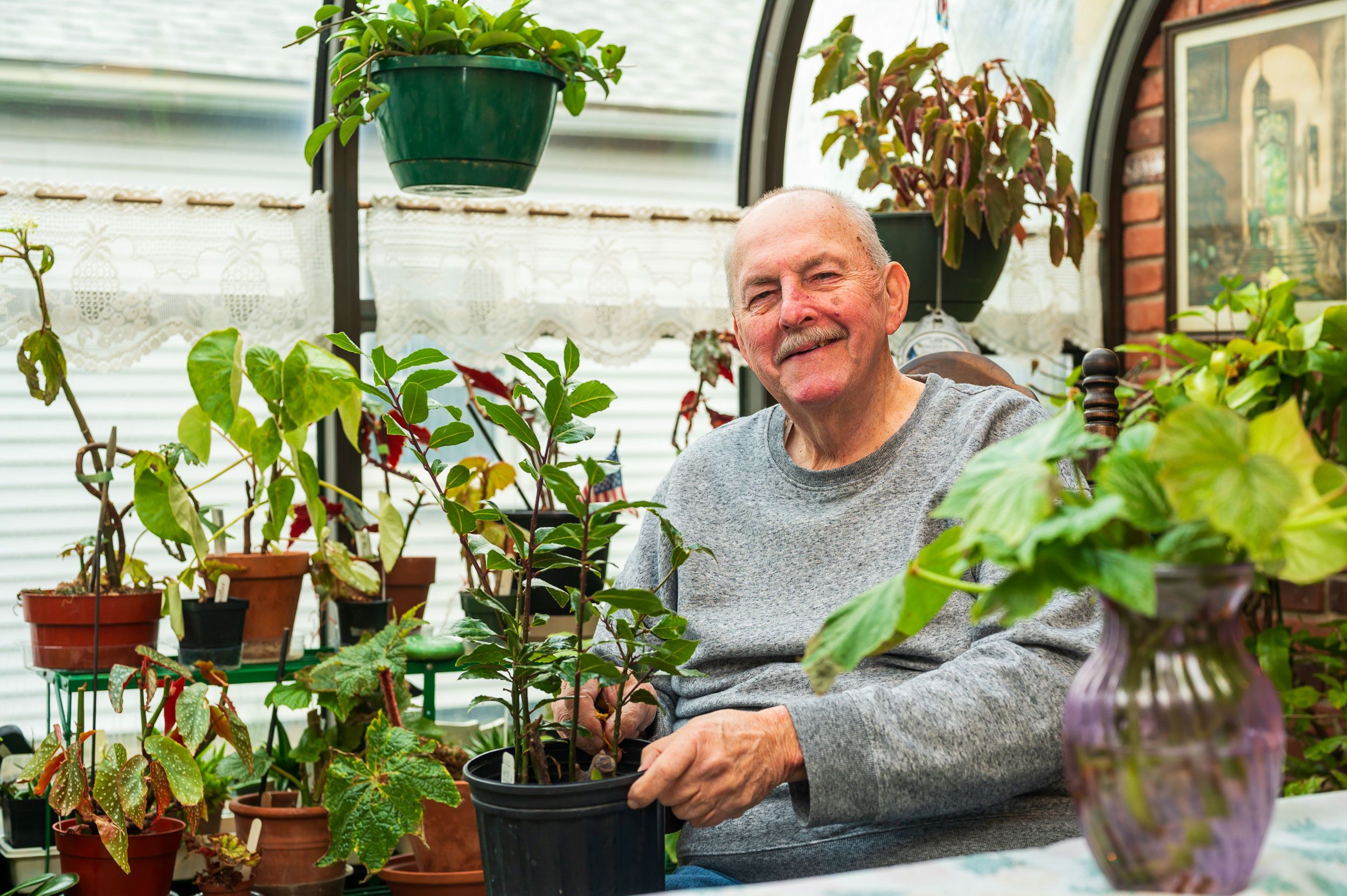
FIVE MORE HONOREES
Every year, PHS celebrates people who have made important contributions to the PHS mission. This fall, these five were recognized along with Edwin MacFarland.

Carolyn Booker received a 2023 Award of Merit for her work as a leader in developing the “Love Where You Live” plan for the Nicetown and Tioga neighborhoods.
I’ve been in my home for 42 years, and I fell in love with my huge backyard, which is rare in this part of Philadelphia. As I got to know the neighborhood more, I met other like-minded people who wanted to stay connected to the land. We started working together to build the green spaces for the community.

Ed Jesiolowski also was a recipient of a 2023 Award of Merit in recognition of his service as a longtime PHS Volunteer, including the role of Flower Show ambassador chair for 2023.
The Flower Show is a major fundraiser for PHS, and volunteers help to ensure the show can fund its many programs. Personally, I enjoy seeing the creativity and work of the PHS staff and exhibitors and meeting wonderful people along the way. Every Flower Show is a treat, and I get to see it up close.

Carmen von Wrangell, another 2023 Award of Merit honoree, has been a Flower Show volunteer for more than 30 years, as well as an exhibitor and “chair or cochair of this, that, and the other.”
I grew up in the Dominican Republic, where flowers bloom year-round, and I come back to the Flower Show every year for all of the beauty you can see in one place. I love seeing how people take an idea [for an exhibit] and make it come to life.
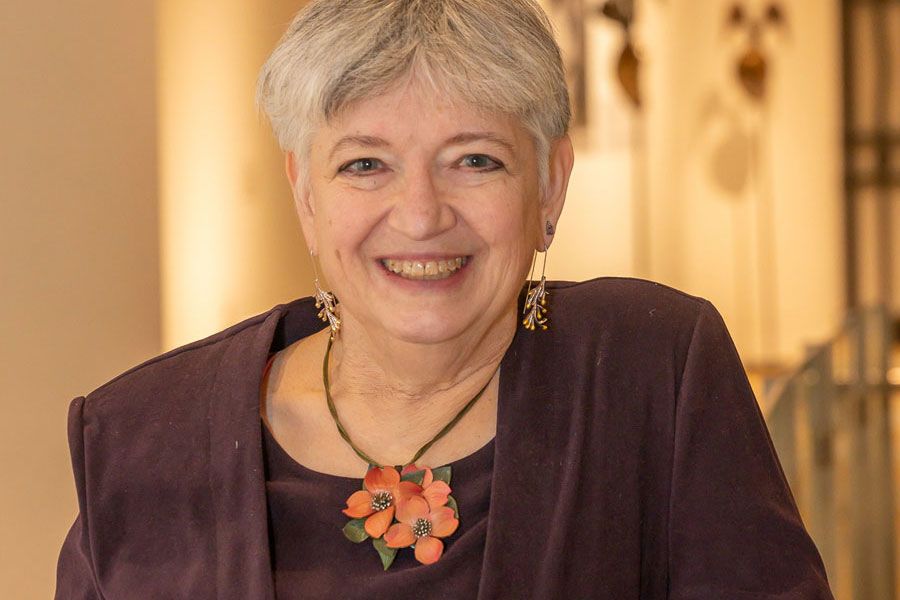
Julianne Schieffer, who is an educator on urban forestry for the Penn State Extension Service, played a key role in establishing the PHS Tree Tenders program and was presented with the 2023 Mary Seton Corboy Award.
PHS has the unique ability and staff to work on the community level and spark engagement that leads to the most effective greening efforts. Where else could I train 10,000 like-minded individuals with green-tinted hearts like mine? It is like winding up folks, giving them the tools, and encouraging them to go out and do good in the world.

Eileen Gallagher was recognized with the 2023 Mary Seton Corboy Award for her more than 30 years of work with PHS supporting community gardeners. She passed away in November 2023, but her impact on the region endures.
“Eileen's legacy will live in on the treasured gardens she helped create like Norris Square Neighborhood Project's Las Parcelas. She always listened to the voices of the communities in driving forward their ideas for leveraging their gardens and green spaces for improved health and quality of life for neighbors.” Justin Trezza, PHS director of garden programs.

100 N 20th Street | Philadelphia, PA 19103
215.988.8800
